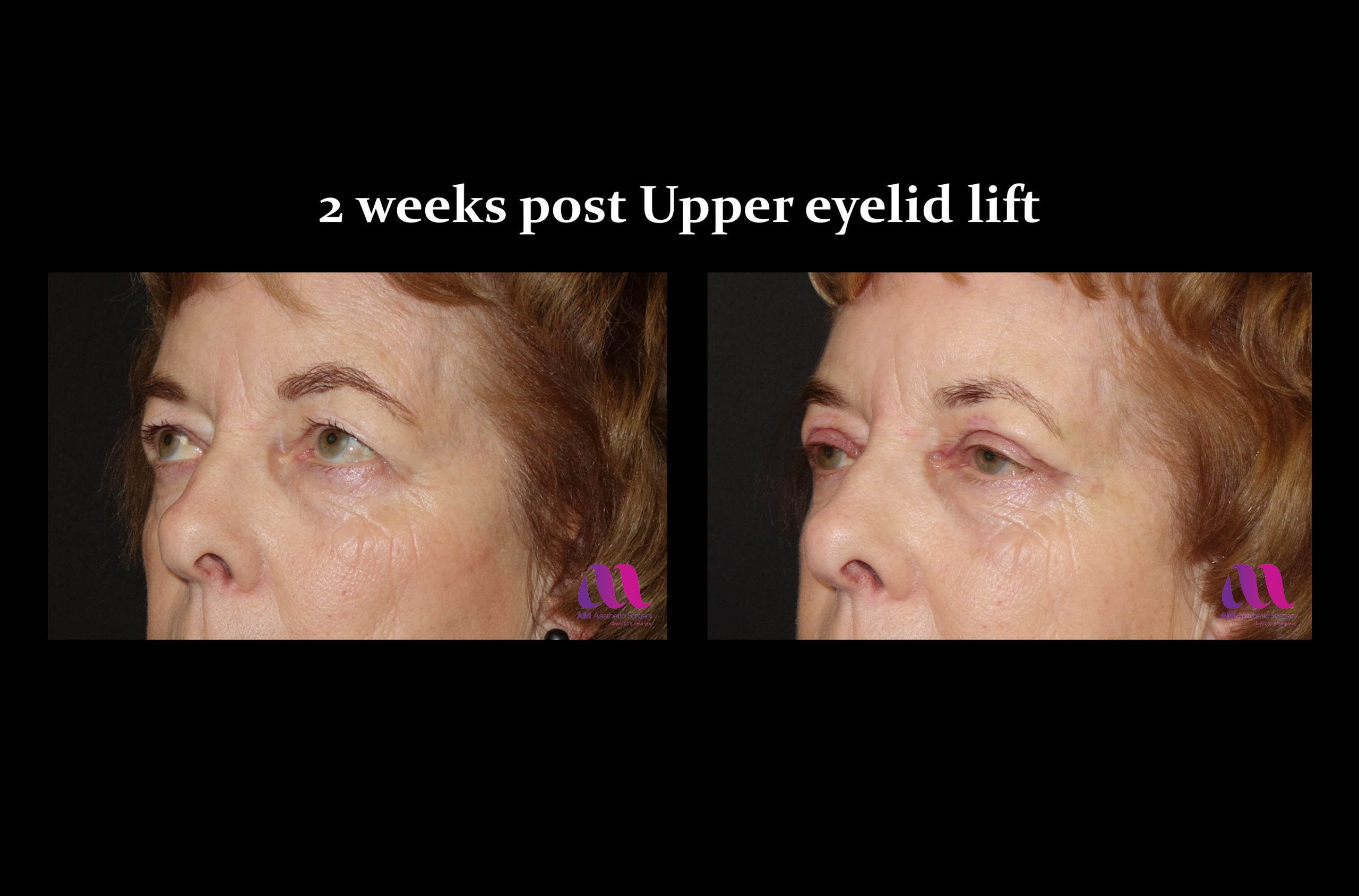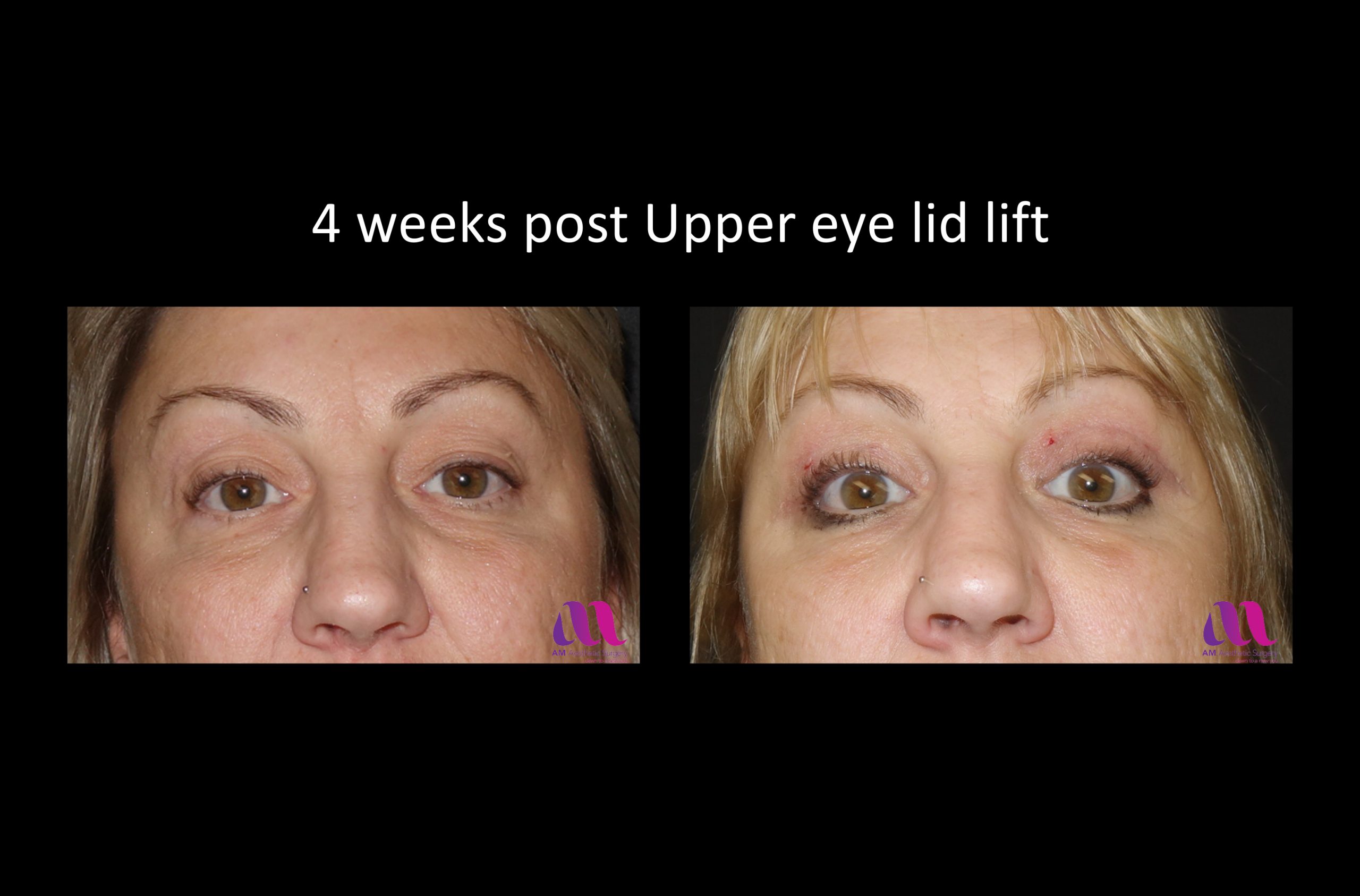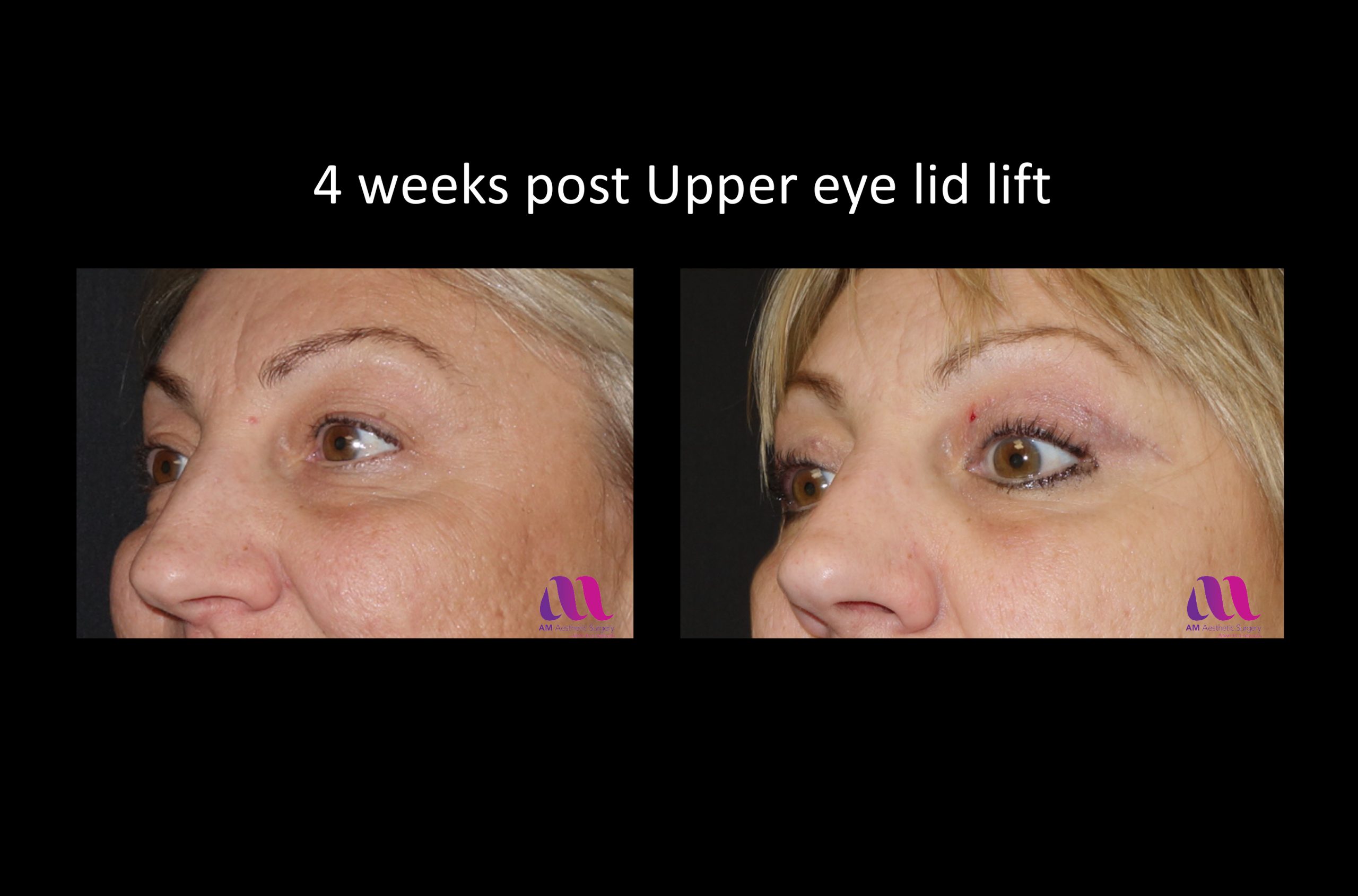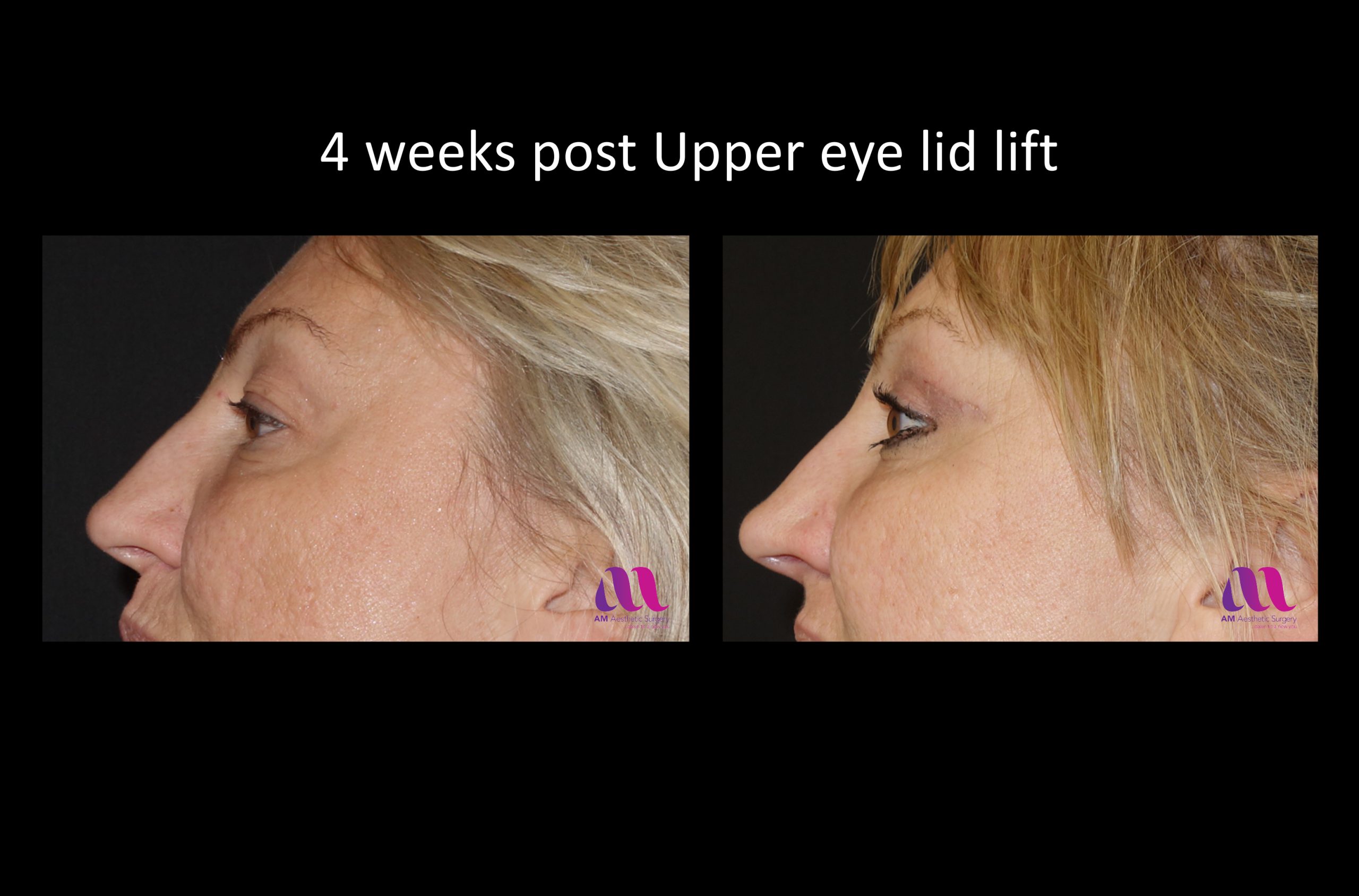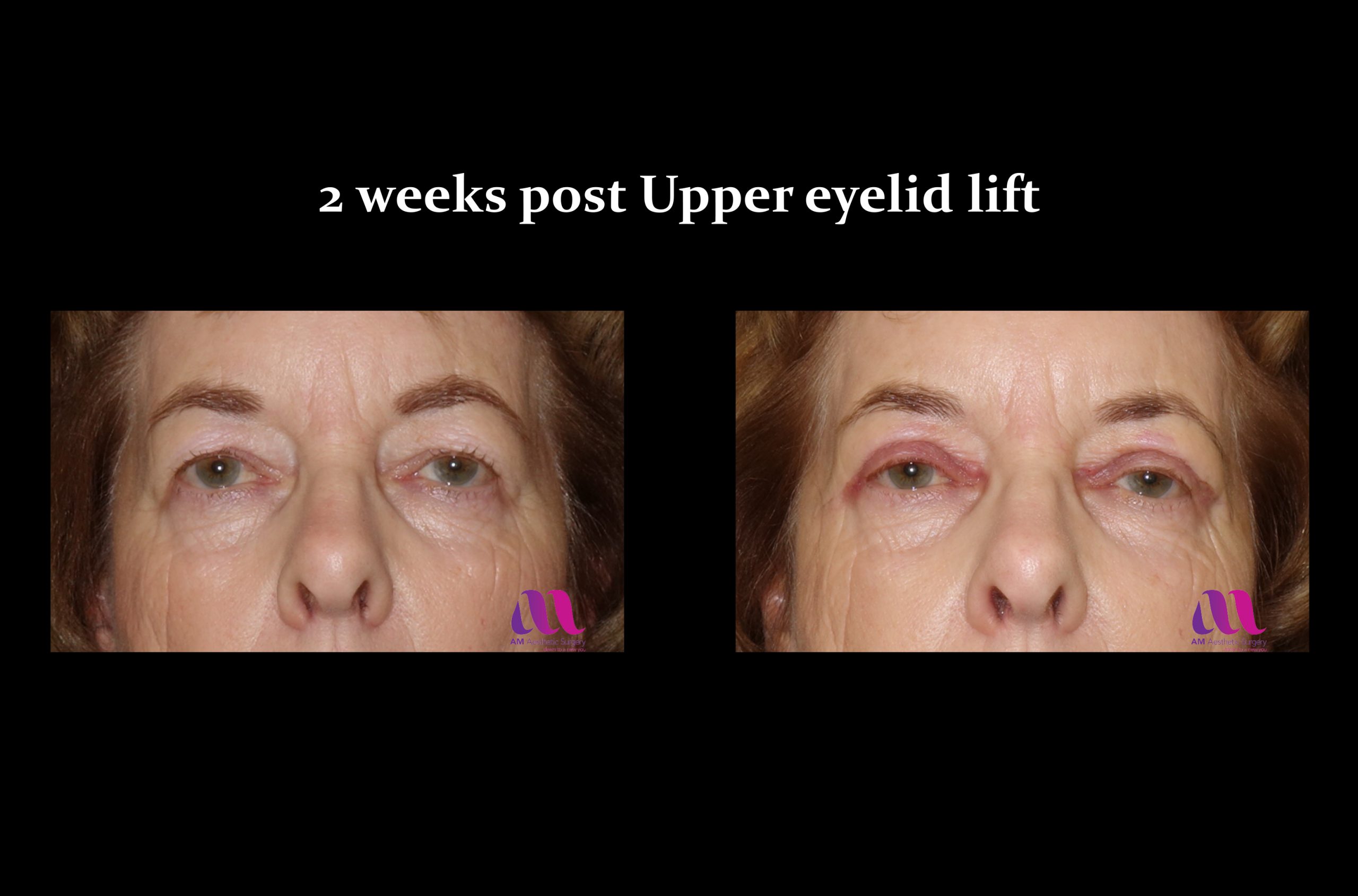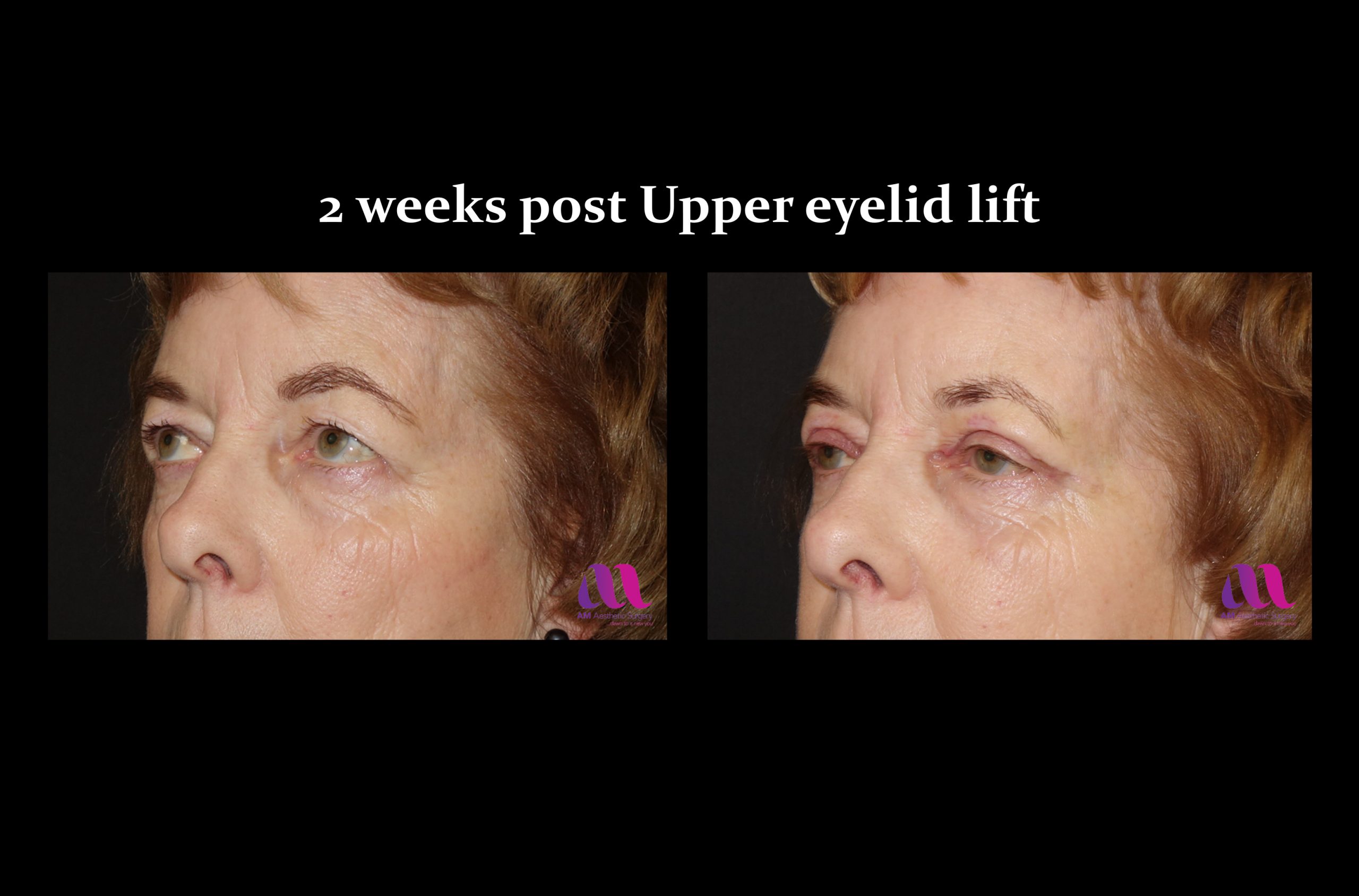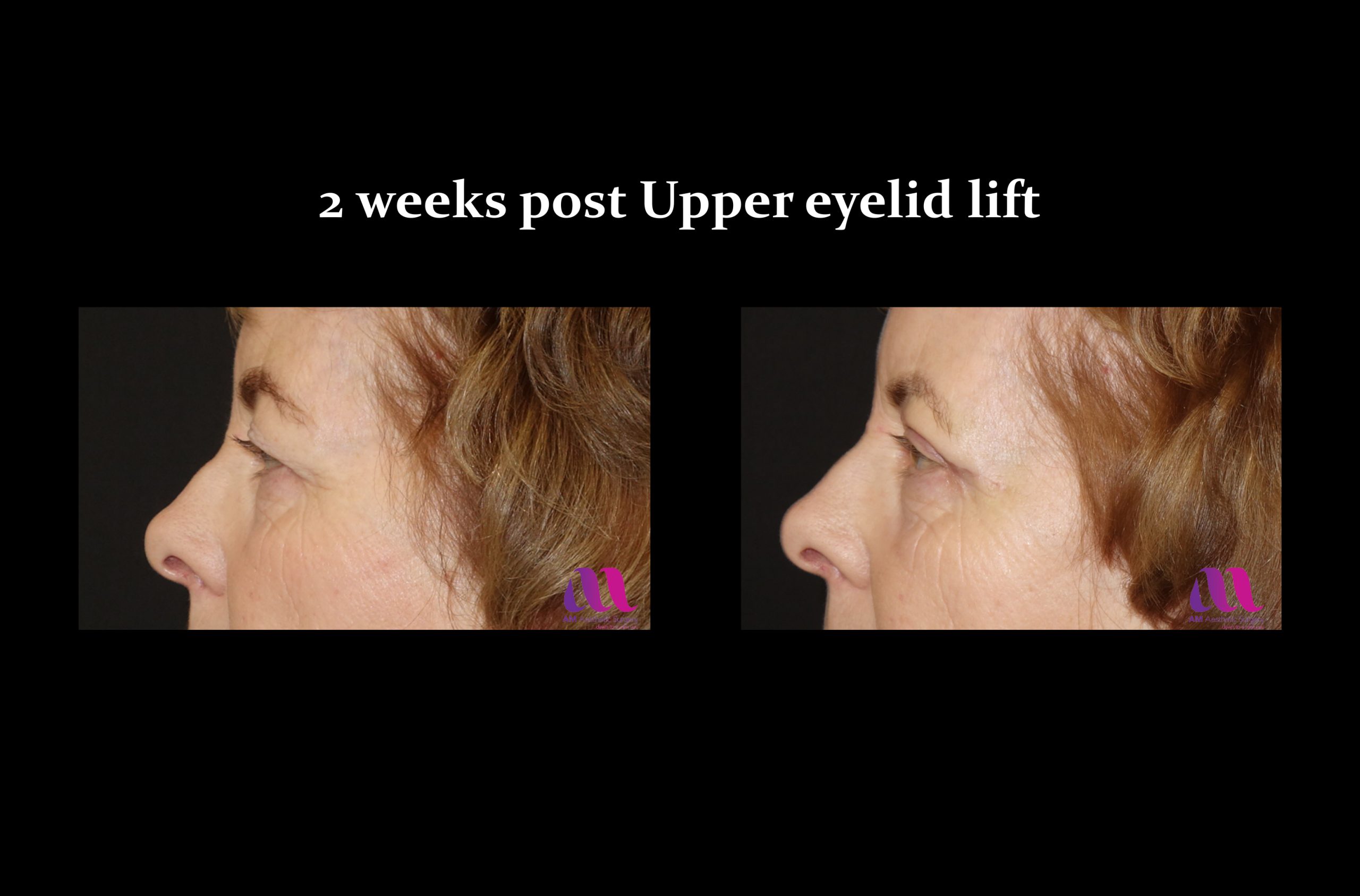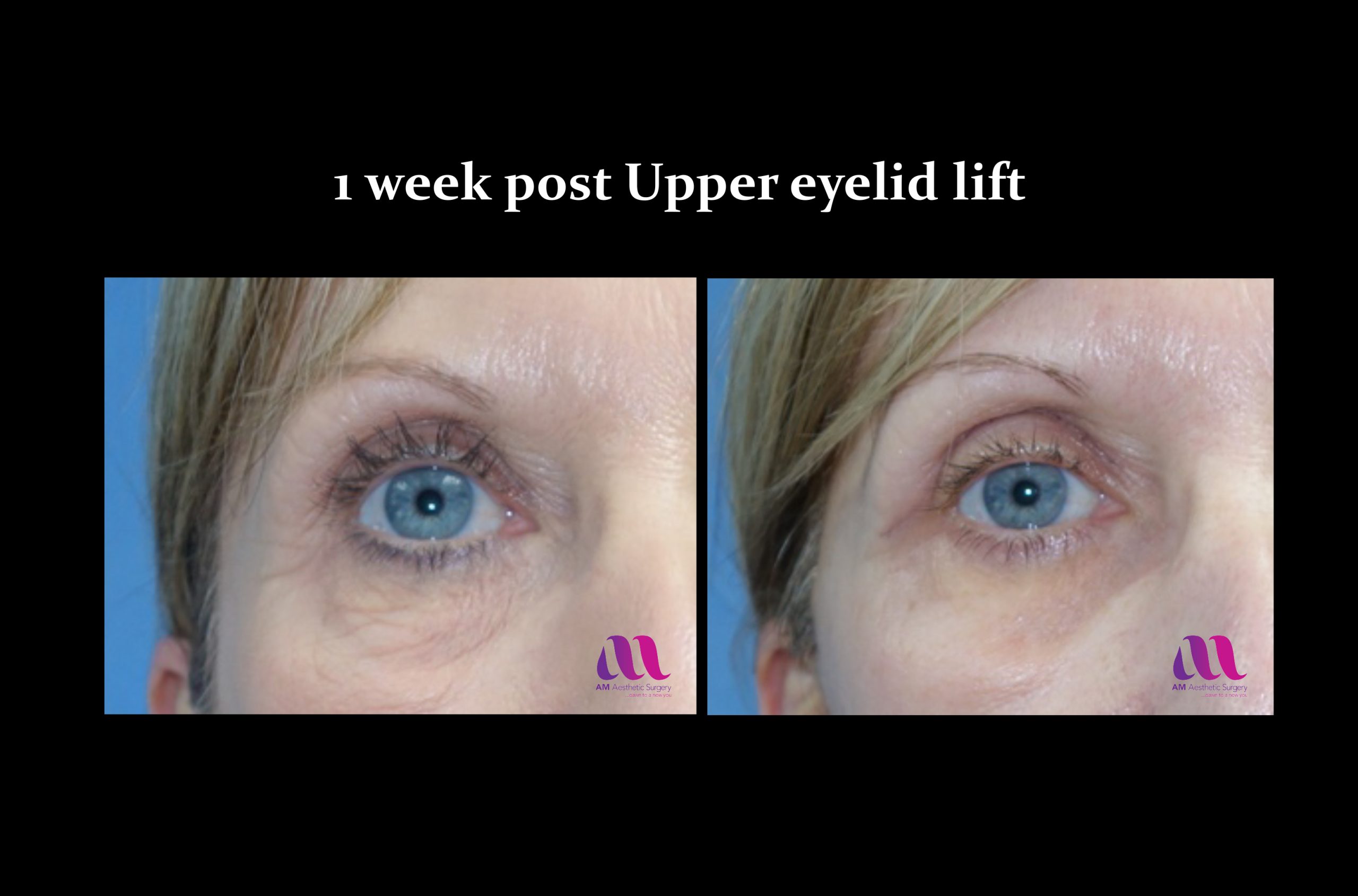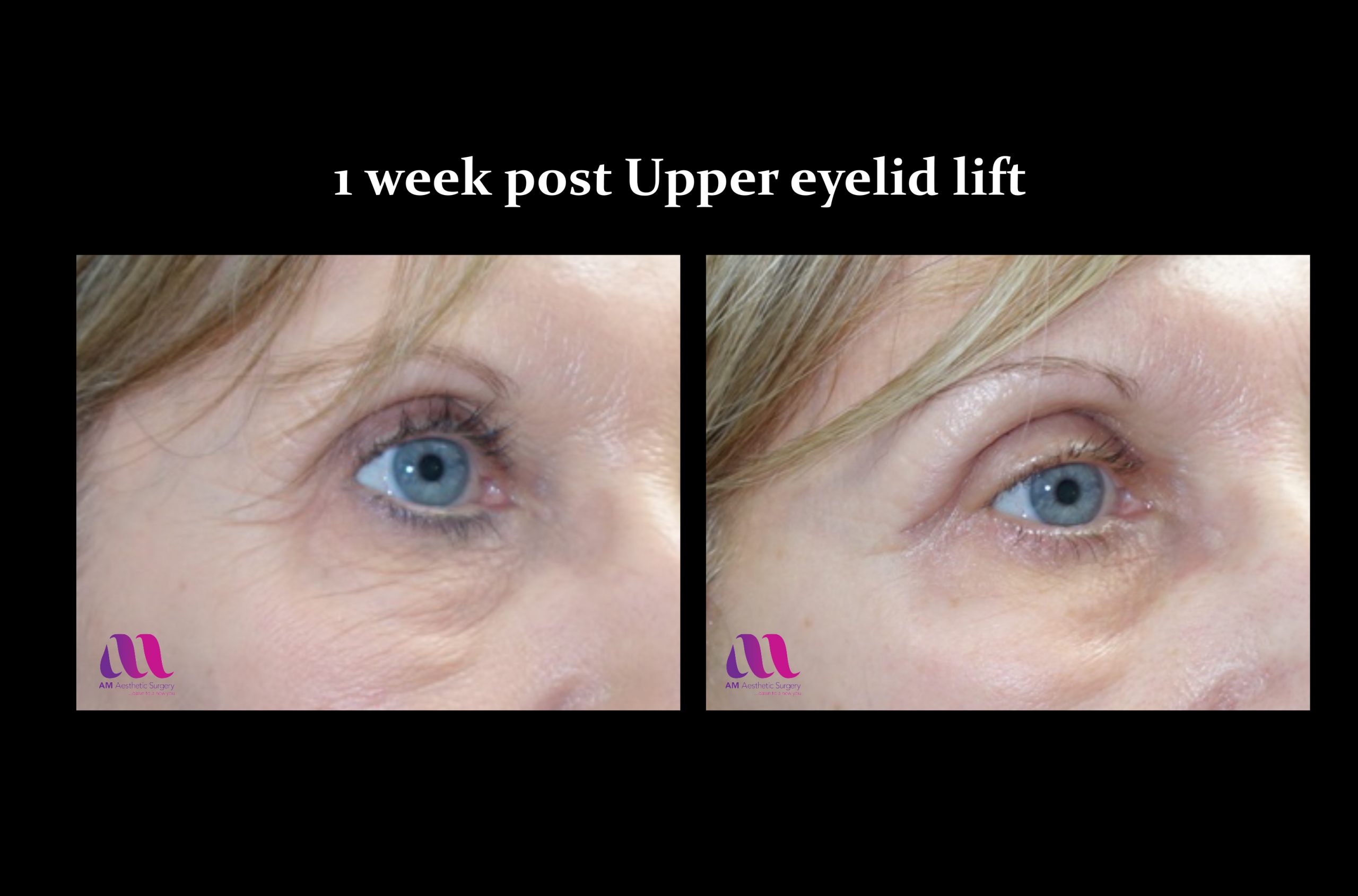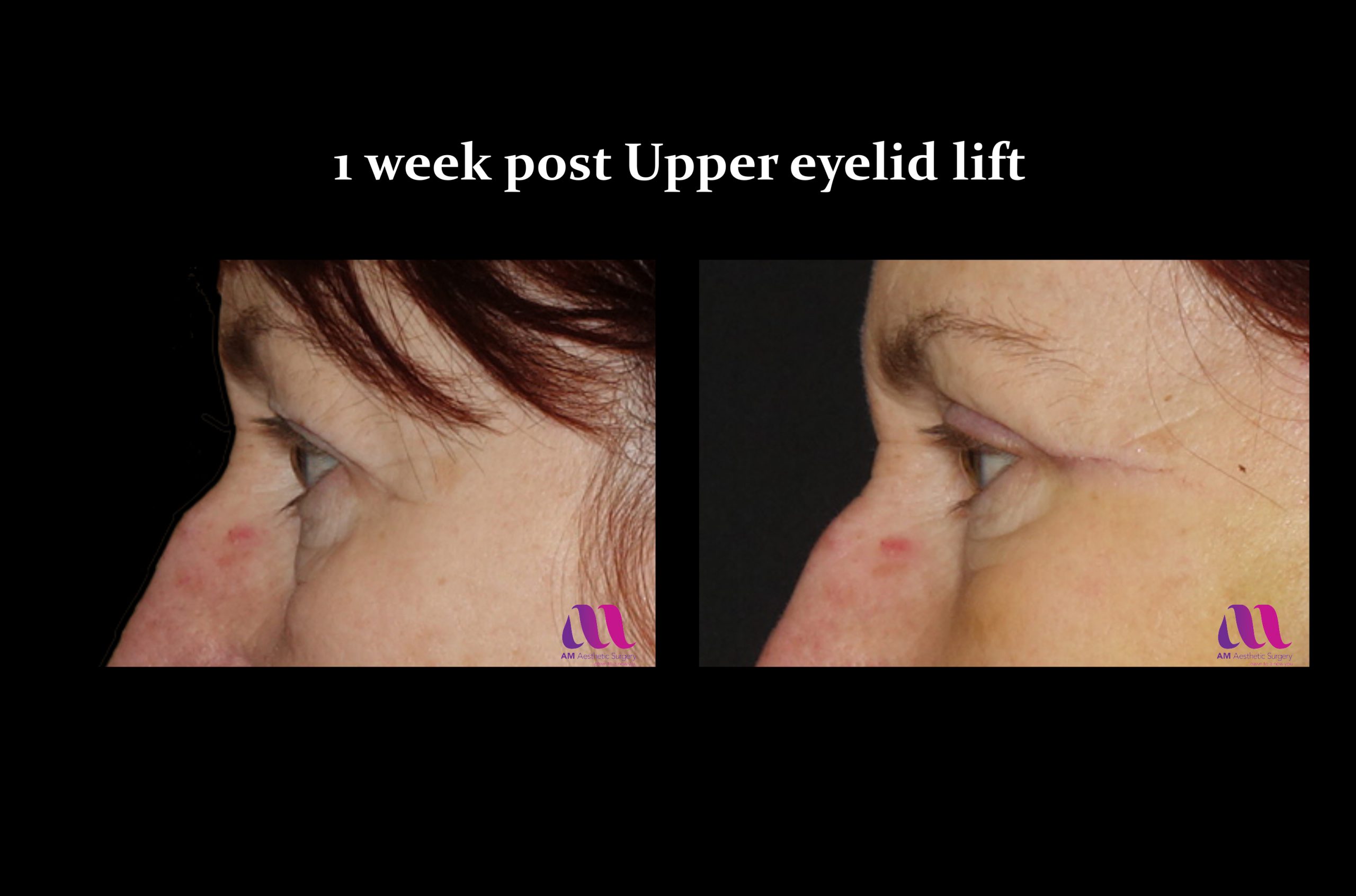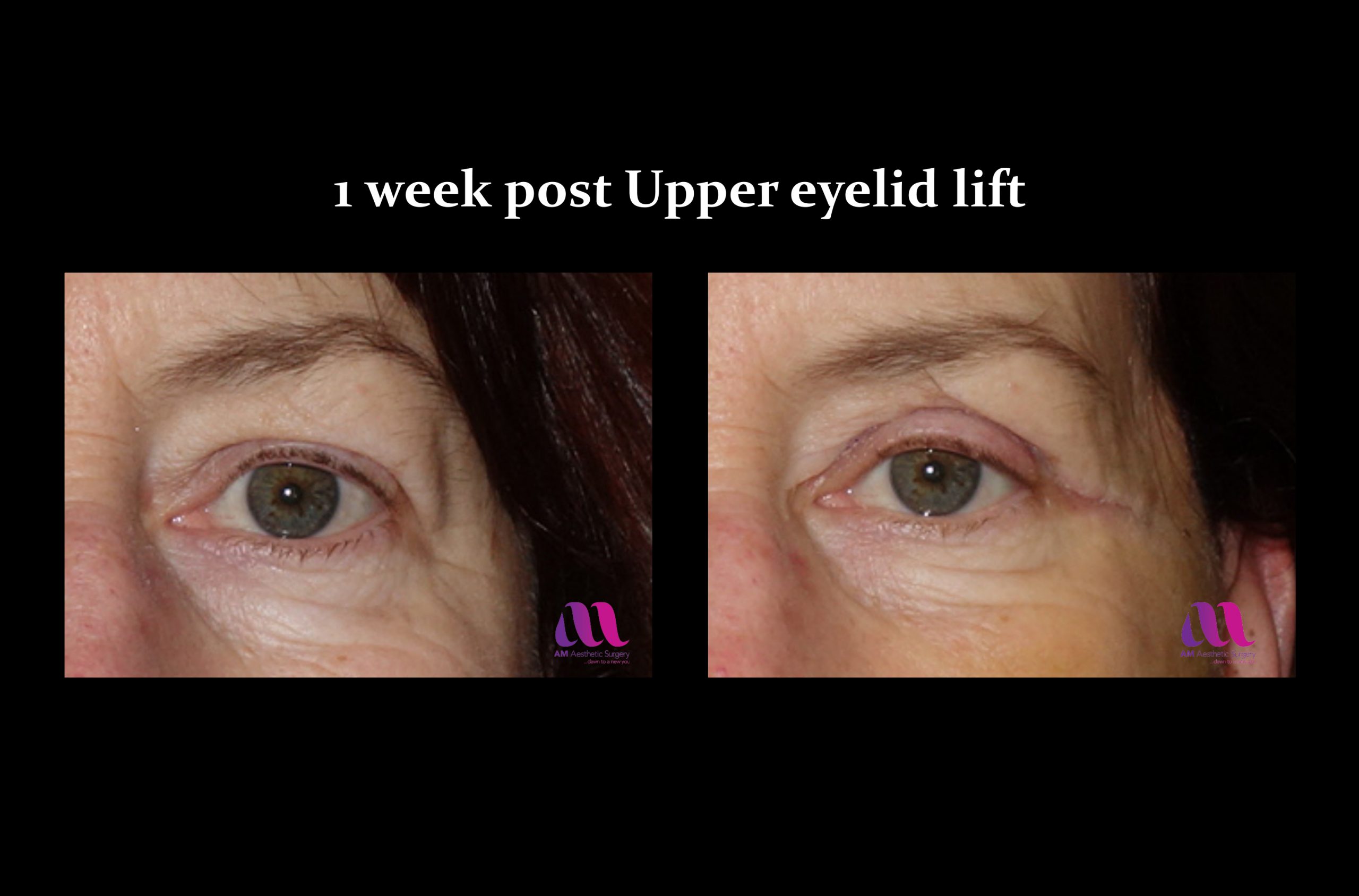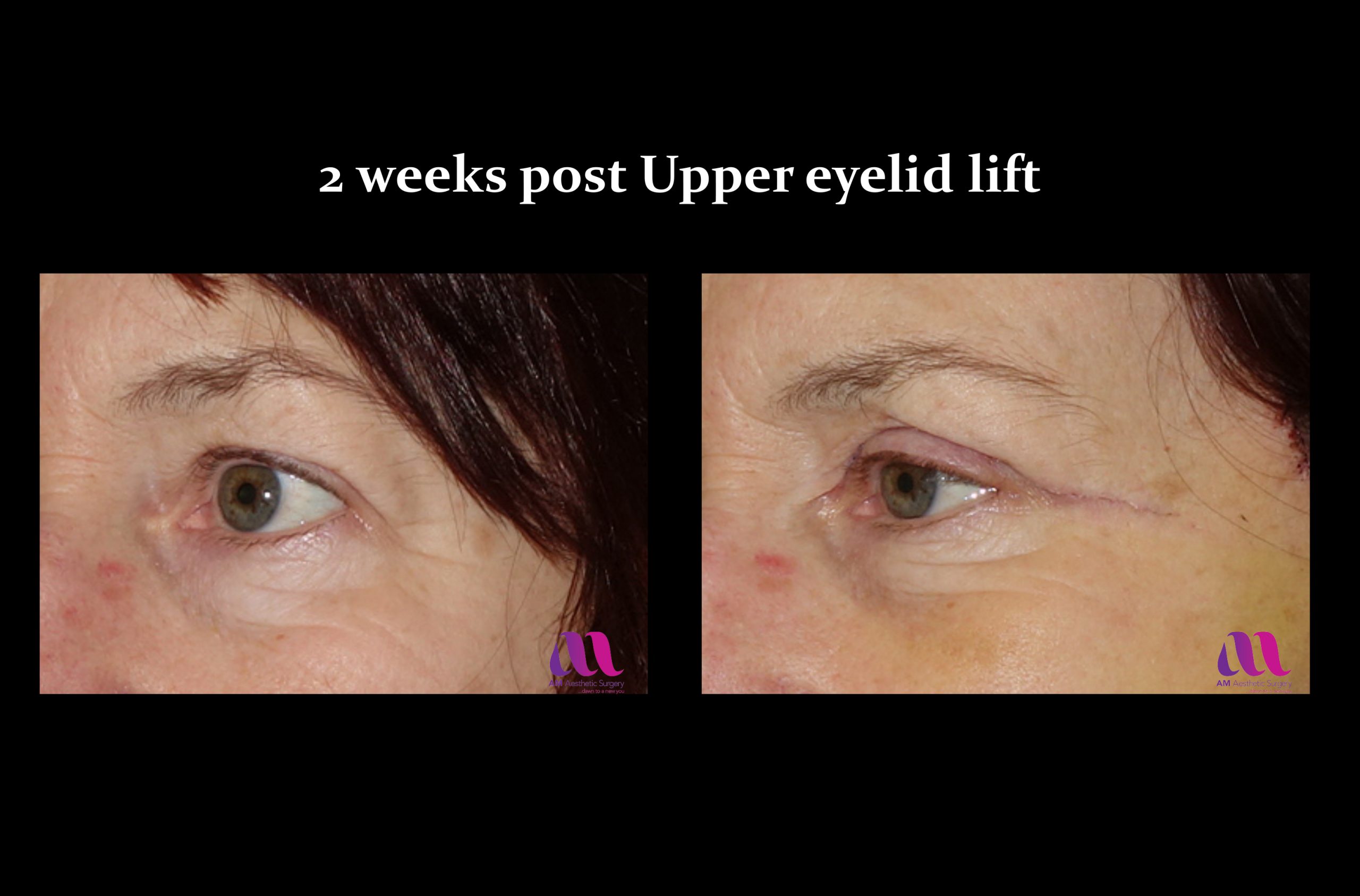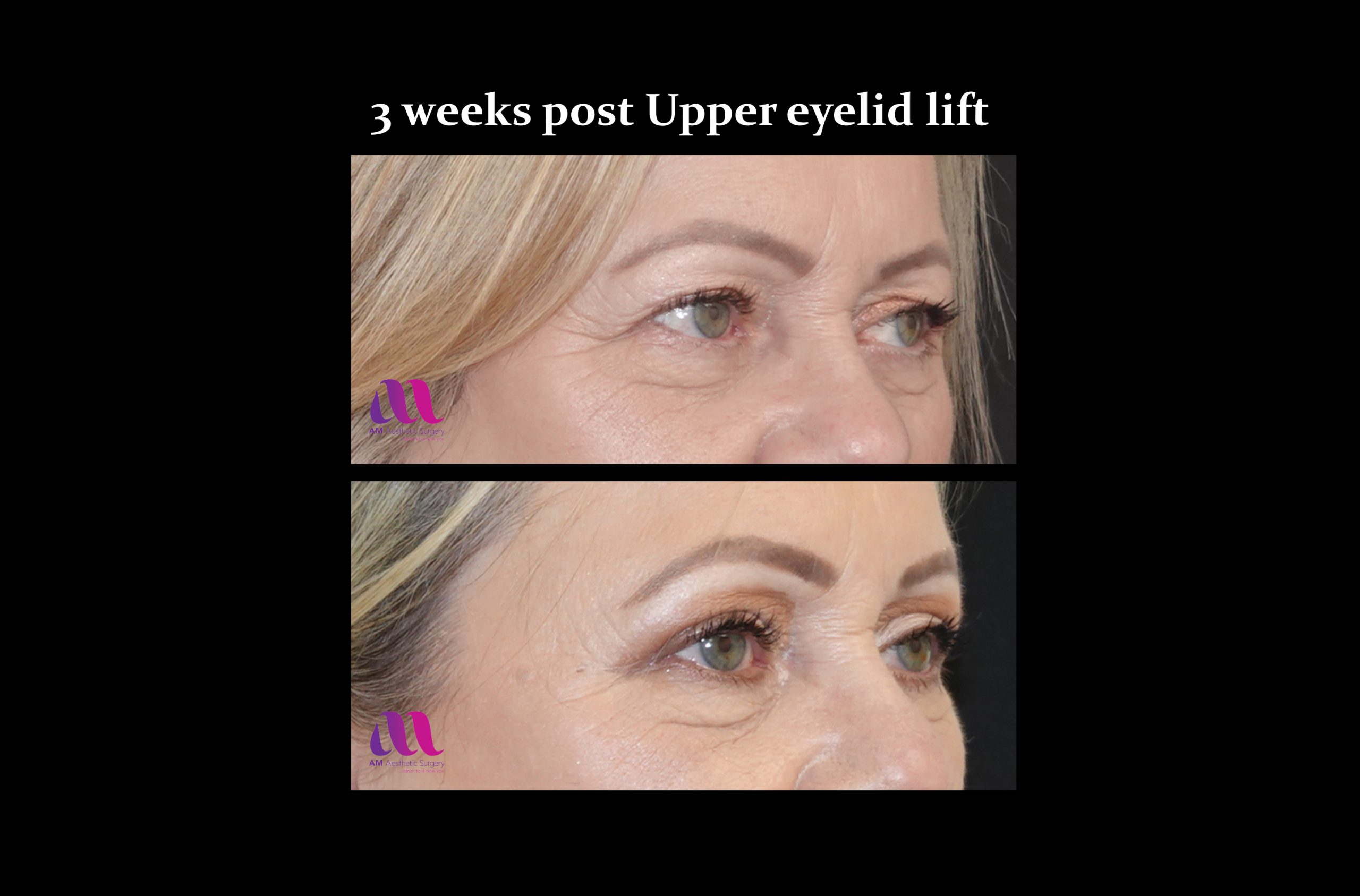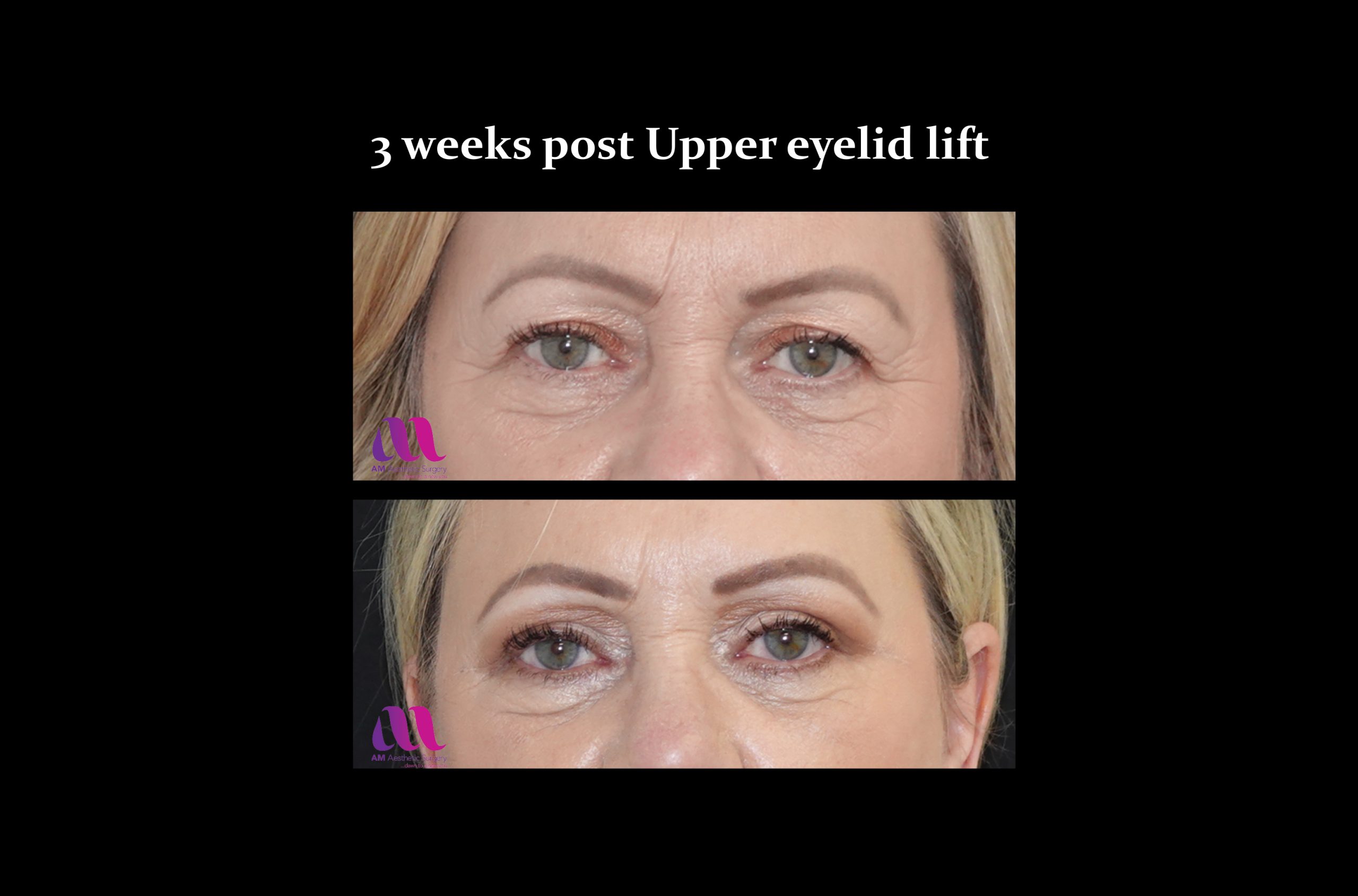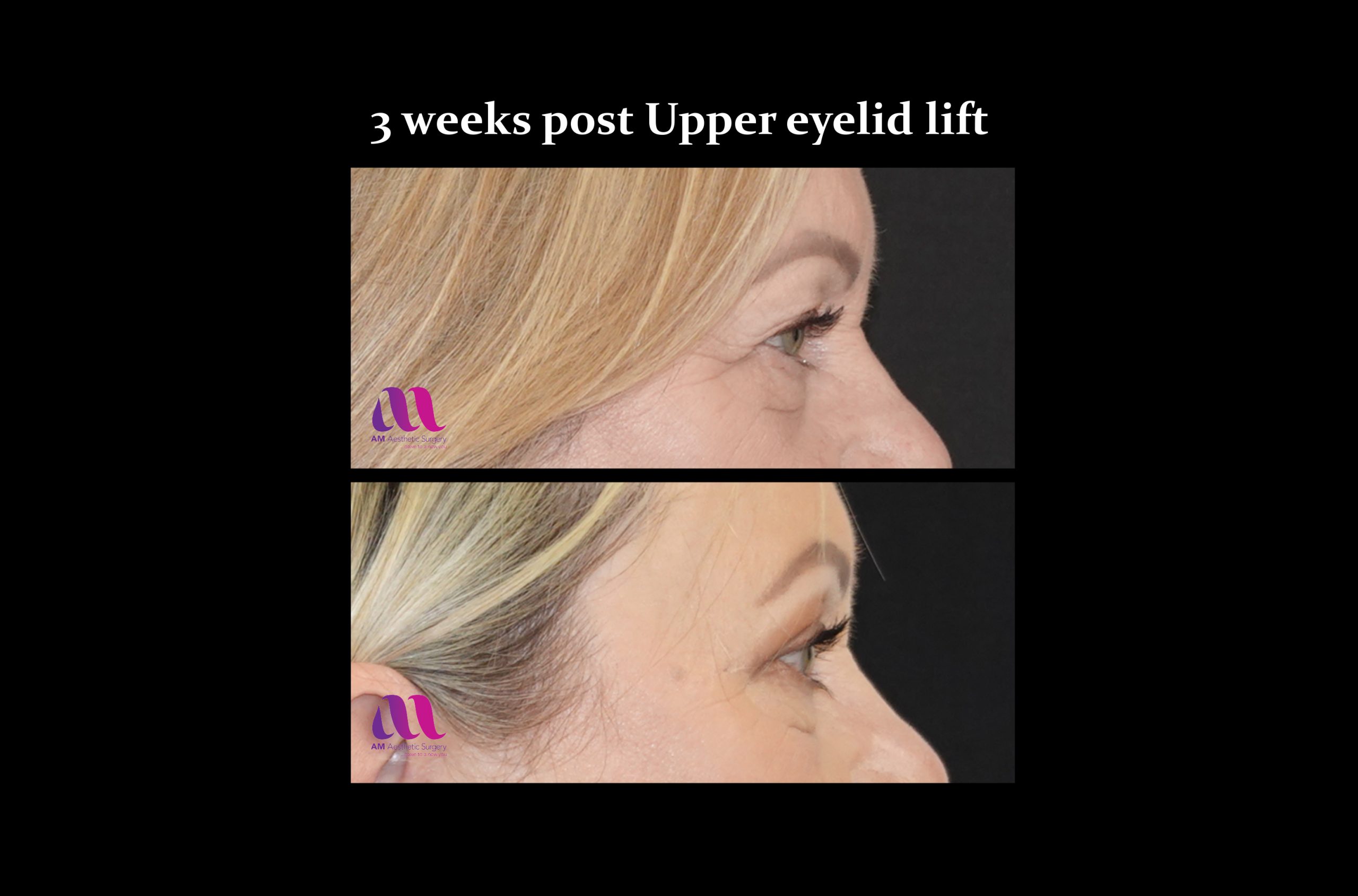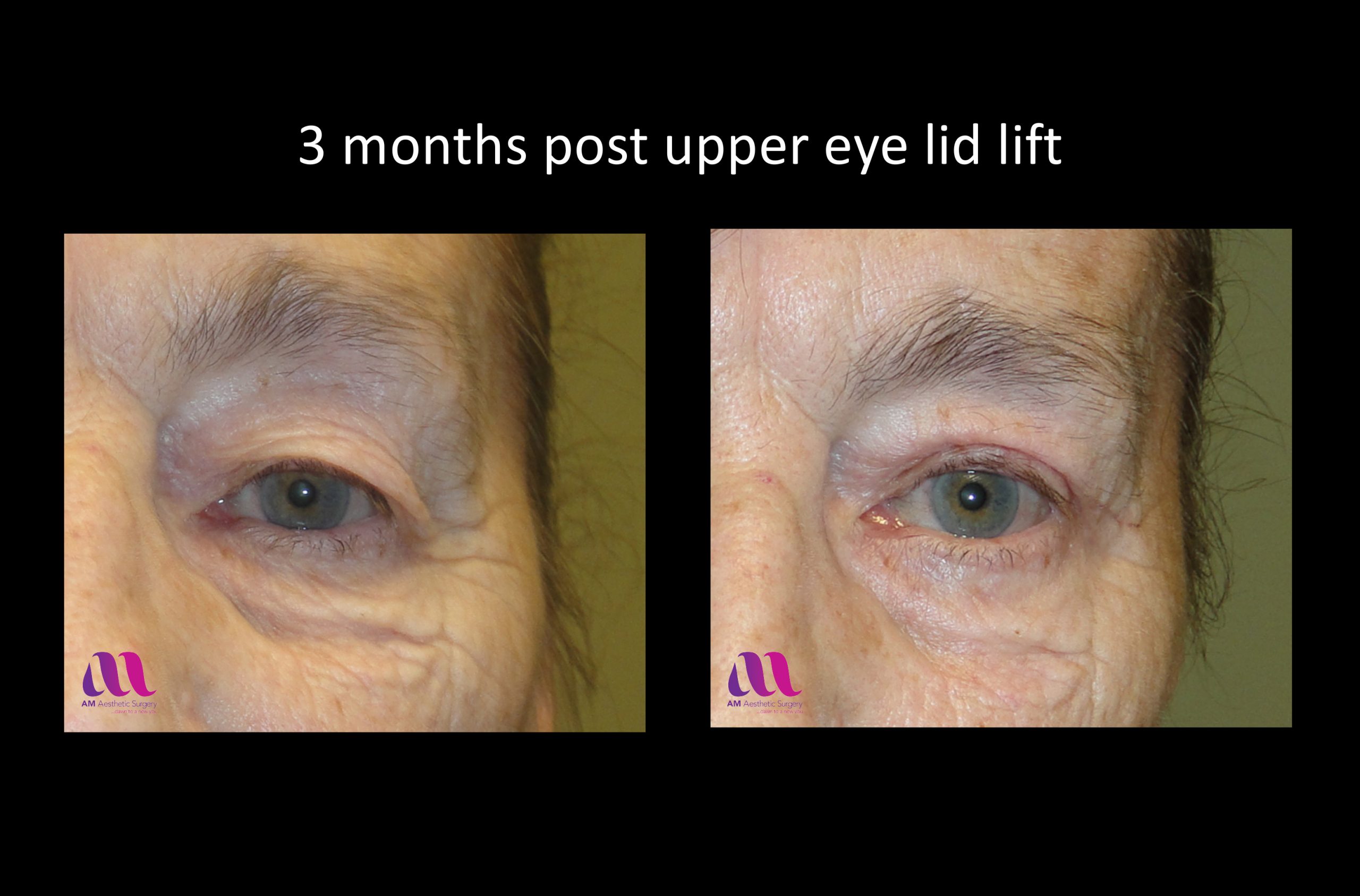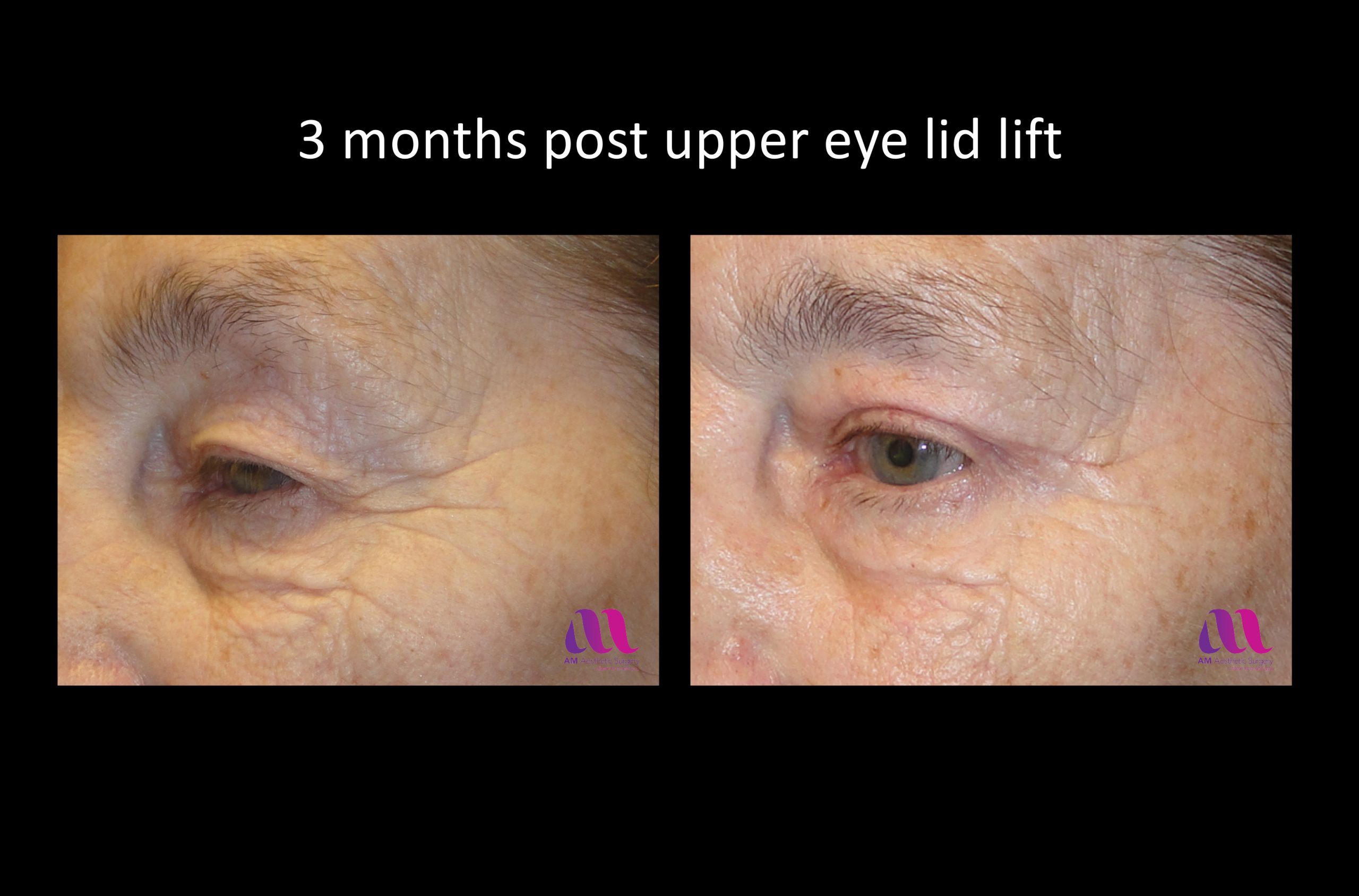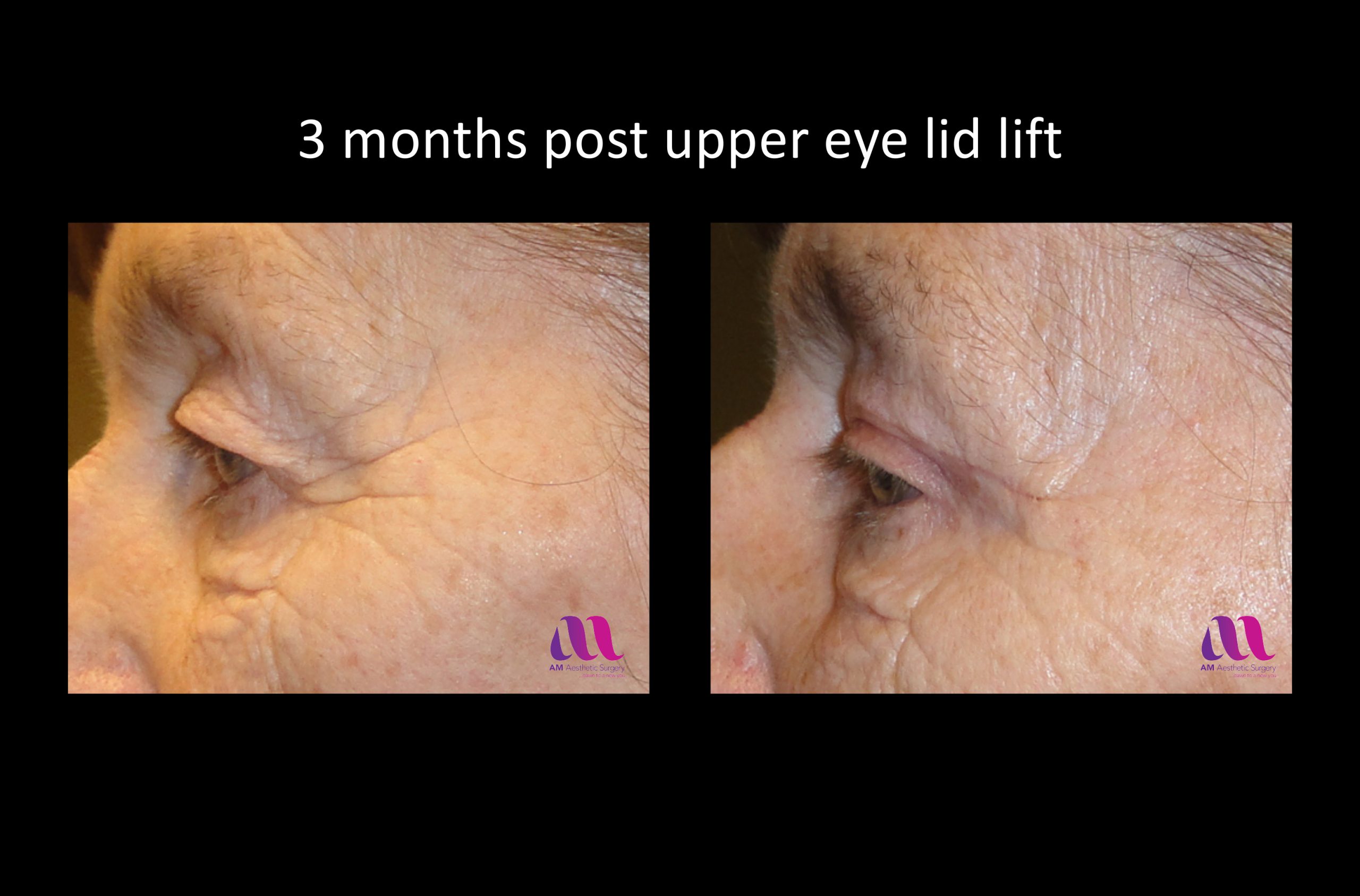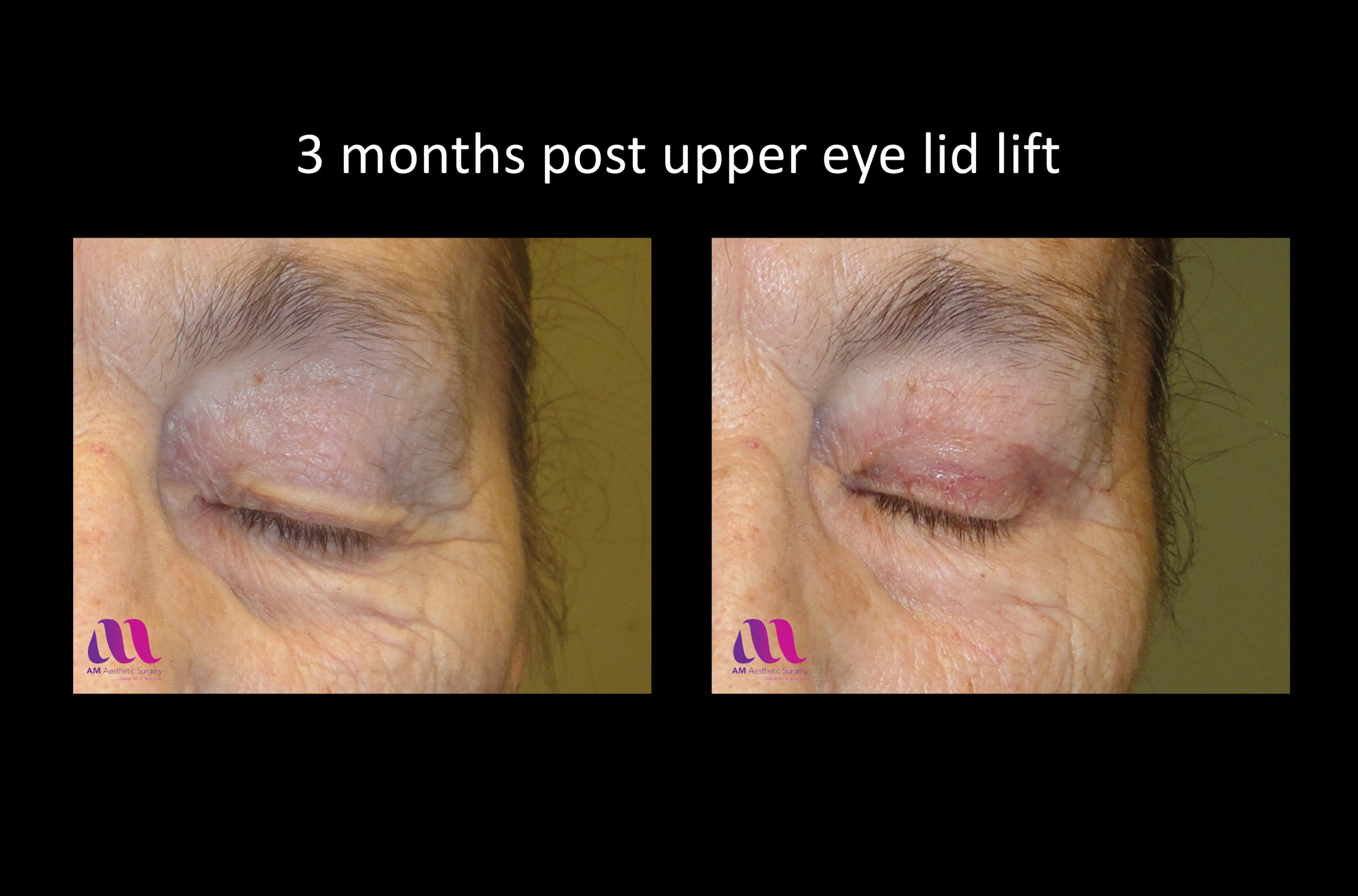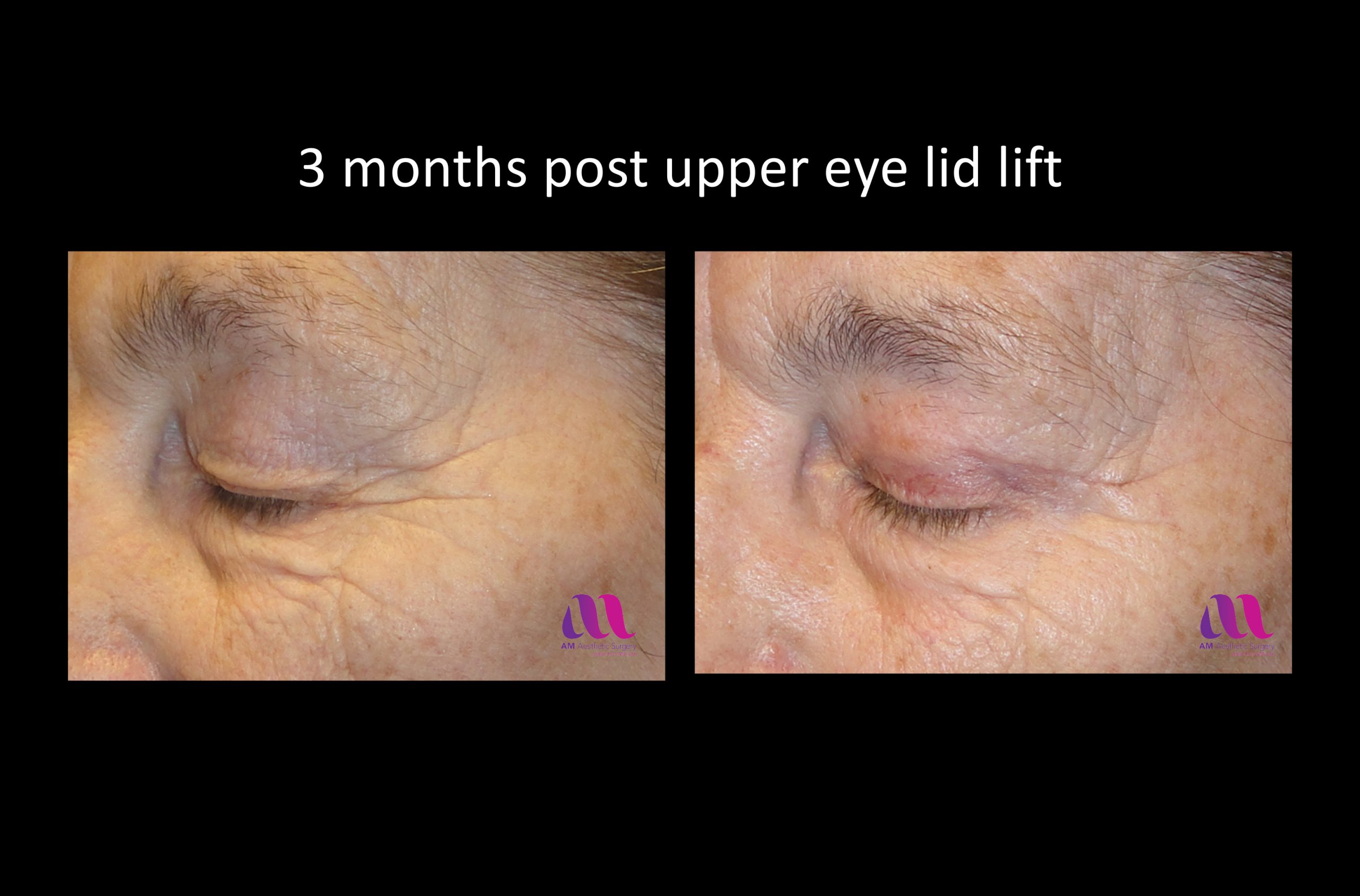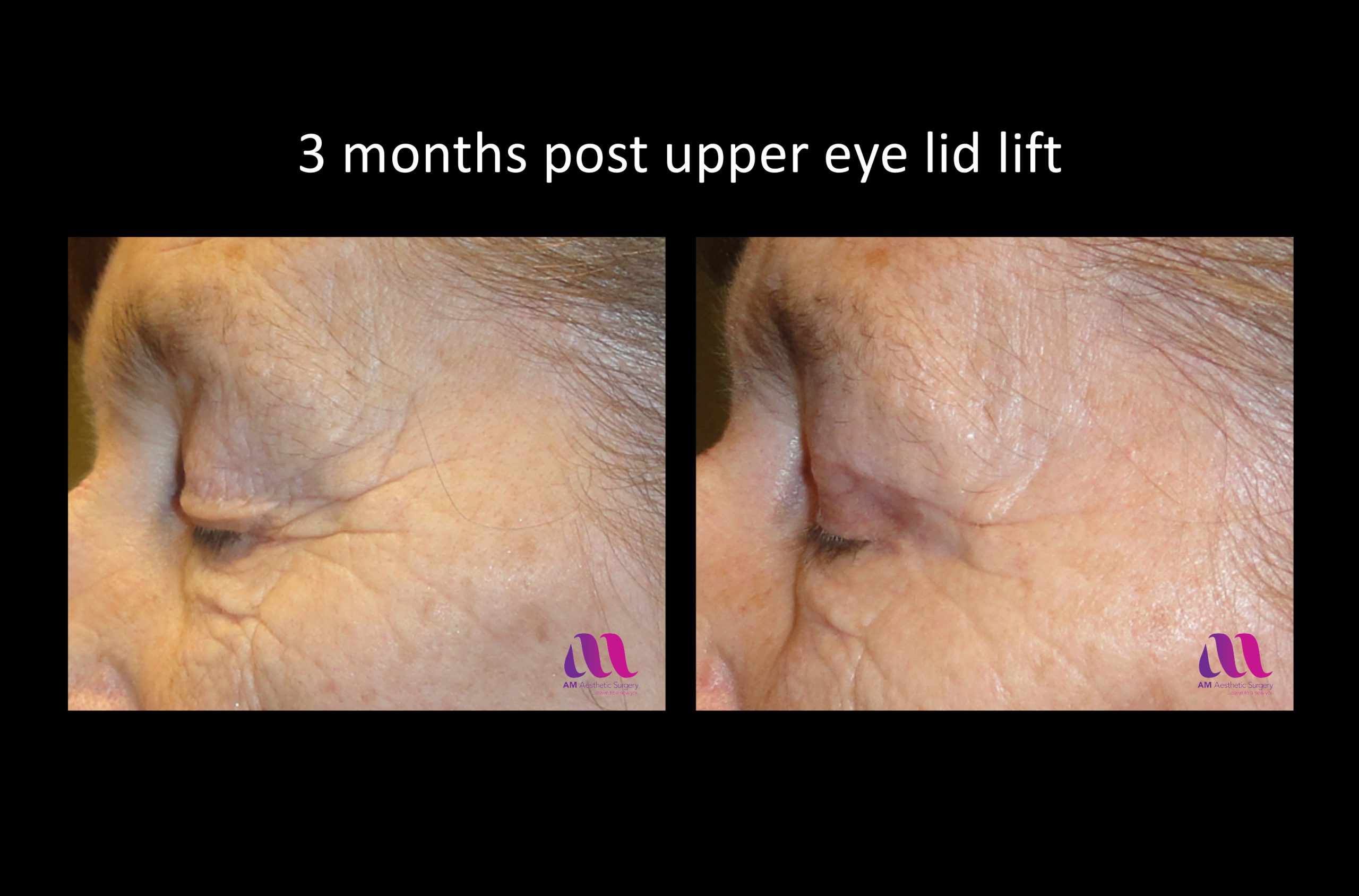With aging there are changes that occur around the eyes that makes a person look very tired all the time. The skin loses elasticity and excess skin in the upper eyelids folds over resulting in a loss of definition of the lid crease and feeling of heaviness in the upper eyelids. If the skin excess is significant, it overflows the lid margin and can be seen in the upper field of vision, almost like a curtain.
In the lower eyelids, the loose skin tends to sag and the eye lids look puffy due to changes in the underlying tissue. The fat pads in the lower eyelids are held behind a taught orbital septum that is attached to the eye socket (orbital rim). But with aging, this septum becomes lax and the fat behind it tends to bulge out. With aging the mid face also loses volume and droops down. As a result a groove (tear trough) forms between the lower eyelid fat pads that are held above the orbital rim with the orbital septum and the malar fat pad (fat over the cheek bones) that droops down.
The appearance of the eyelids can be improved by surgical or non-surgical techniques. Non-surgical techniques involve injecting fillers or fat in the lower eyelid. Surgical techniques involve removing excess skin, tightening up the lower eyelids, releasing the orbital septum and repositioning the lower eyelid fat pads.
The procedure required depends on the problem, Professor Mahajan carries out a detailed examination and plans the surgery accordingly. Sometimes a brow lift (forehead lift or eyebrow lift) may be required in conjunction with a upper eyelid blepharoplasty (upper eyelid lift). Similarly, a midface or face lift may be required with a lower blepharoplasty (lower eyelid lift) procedure. This will be discussed with you in detail following your assessment.
The eyelid lift procedures aim to give you a fresh youthful look, with the eye lids looking smoother and better defined. If your expectations are realistic, you will always be happy, if not, you will always be unhappy irrespective of how good a job your surgeon might have done!
This procedure is often combined with face lift, mid face lift, brow lift or fat transfer to areas in the face to help achieve a global rejuvenation of the face.
WHO IS EYELID SURGERY FOR?
- Ladies or gents with loose excess skin in the eyelids
- Ladies or gents with prominent bulging fat in eyelids
- Ladies or gents with grooves under eyelids.
WHAT DOES A EYELID SURGERY ACHIEVE?
- Removes excess skin from the eyelids and defines the upper eyelid crease.
- Reduces bulging of lower eyelids.
- Reduces prominence of groves under the lower eyelids.
- Gives the eye lids a smooth contour.
EYELID SURGERY TECHNIQUES
- Upper Blepharoplasty (Upper Eyelid lift).
- Lower Blepharoplasty (Lower Eyelid lift).
- Lower Blepharoplasty with segmental fat graft
EYELID SURGERY NEED-TO-KNOW INFO
- Duration of surgery: 1hr for upper and 2 hrs for lower
- Anaesthesia: Local or General Anaesthetic for upper, General Anaesthetic for lower.
- Duration of inpatient stay: Day case surgery for upper, 1 night for lower.
- Wounds healed in: 1 week
- Scars matured in: Settle in 3 to 6 months, fully matured in 12 to 18 months
- Back to light work (Desk job): 2 weeks
- Back to cardiac exercise / fast walking: 2 to 3 weeks
- Back to labour intensive work / Exercise: 4 to 6 weeks
- Sexual activity: 4 to 6 weeks
- Able to drive: 1 to 2 weeks (Should be able to see clearly and apply emergency stop)
- ‘Long haul’ flights / holidays: Avoid four weeks before and after if having a general anaesthetic. Short flights are okay but take precautions.
- Shower / bath: Keep dressing dry for one week but pamper yourself with a sponge bath.
- Sun bathe: Keep the scars covered or protected with a high factor sun protection cream until they mature in about a year or so.
- Garments: None, dressing tape for 1 week.
- Avoid contact lenses for 4 weeks and makeup for 2 weeks.
- Post-operative review: 1 weeks, 3 months (As often as necessary if clinically indicated)
- Post-Operative pain / discomfort: 2 to 3 days
- Potential risks: (Every effort is made to reduce the risk of complications, but potential risks are) Bleeding, bruising (‘black eyes’), swelling, haematoma, infection, delayed wound healing, skin necrosis, scars – hypertrophic, stretched, sensitive, asymmetry, numbness, lagophthalmos (inability to close eyelids fully), Ectropion (pulling down of lower eyelid, Corneal abrasion, Conjunctivitis, watering of eye, dry eyes, Chemosis (fluid retention in white of eye), Residual skin excess or fat prominence, Blindness with lower eyelids surgery, risks associated with general anaesthetic, blood clots in legs or lungs.
“I had eyelid surgery with Mr Mahajan at the Yorkshire Clinic. At my consultation with Mr Mahajan he was very professional, helpful and friendly. He enquired about my expectations and then proceeded to answer all my questions and explain the procedure. He has a very calm manner which immediately put me at ease. I have never had any surgery in the past so was obviously nervous. On the day of surgery everybody at the Yorkshire Clinic was very friendly and reassuring. The procedure itself was problem free, I had no pain at all afterwards, only taking Ibuprofen for a couple of days for the swelling. I had the surgery 6 weeks ago and have very little scarring. I am more than delighted with the results, I wish I’d had it done sooner. Mr Mahajan is a very professional, talented surgeon and I would 100% recommend him.”
//www.realself.com/review/upper-eyelid-surgery-delighted
“I decided earlier this year I would like eyelid surgery, not knowing anyone or having any recommendations I spent hours researching surgeons and each time I would return to Mr Mahajan. I took the plunge made my appointment and had my surgery. Right from the start I had no concerns or worries about my choice and now have the eyes I’ve always wished for. I can assure anyone considering surgery that you are in safe hands with Mr Mahajan he is a exceptionally skilled surgeon and a genuinely caring person and thank him so much for my experience.”
//www.realself.com/review/eyelid-surgery-eyes-i-ve-wanted
“such a pleasent experience.
Thats the words i will use to anyone who asks.I cannot speak highly enough of mr Mahajan.
first visit for my consultaion and i was immedietly put at ease and the whole process was explained fully and this was only a mini consultation.second consultation was a full one and any questions i had were answered fully.such pleasent and profesional approach that made me fully aware of the whole process from start to finish..then it was onto the actual surgery which was done perfectly the after care is absolutly impecable. i would reccomend to everyone ..cannot fault in any way .thankyou again.”//www.realself.com/review/yorkshire-clinic-eyelid-surgery-new-lease-life
“After living with eye bags from being a teenager I finally plucked up the courage to do something about it. I read up as much as I could about the process and more importantly the surgeons. I was looking for professional reviews on surgeon success rates but instead had to rely on patient reviews. I chose to have a free consultation at the Spire, Elland. I discussed my wishes and hopes with a surgeon who advised that my lower eye bags could be reduced but intimated this was not easy. He recommended I have a further consultation with Mr Mahajan. I read as many internet reviews on Mr Mahajan as I could find and all were good. I met Mr Mahajan for an initial consultation when he advised of the procedure and confirmed that I should see good results. Importantly he recommended that I should consider having my upper eyelids lifted as this was much easier and would give a better outcome. The consultation was charged but deducted from the operation fee if I went ahead. Mr Mahajan was very calm and everything he said gave me confidence in his ability and I agreed to go ahead. I fixed a date and the hospital kept in touch. The operation was performed as booked and was painless. I had to wait a week to remove the stitches and strips to see that the upper eyelids looked better already but the lower eye bags were swollen and slightly bruised under my left eye. Mr Mahajan seemed disappointed to see the bruising; I guess that was professional pride. He advised to massage the lower eyes but I developed a blood blister on the sclera of the left eye, which was irritated with the massaging. The blister slowly disappeared and the eyes settled. Four months on and I am delighted with the results. The bags are not gone but they are much less pronounced and several friends have commented very favourably. You quickly get used to how you look but I only need to look at old photos to see the big improvement. I am very happy with the entire process start to finish and can recommend Mr Mahajan.”
//www.realself.com/review/spire-elland-uk-eye-bags-treatment-tired-eyes-needed-lift
Professor Mahajan will acquire a detailed history from you about your concerns and your medical history. He will take the time to understand your desires and discuss in detail as to how he can achieve the results you want. A detailed examination involving assessment of the eyelids, overlying skin, underlying fat and tone of the eyelids will be noted. Adjacent areas of the forehead and mid face will also be assessed.
Depending on your examination a treatment plan will be formulated tailored to your needs. Depending on the characteristics of your face, Professor Mahajan will discuss surgical options with you. Sometimes fat grafting may be necessary to produce optimal results. You will together be able to decide the procedures that will be used to achieve your desired results.
Pattern of the incisions, procedure and subsequent scars will be discussed in detail and you will be given an opportunity to probe into any aspect of the proposed procedure. Once you decide to go ahead following the consultation, you will be required to attend the pre-assessment clinic to ensure you suitability for the procedure under general anaesthetic. You will need to stop smoking (including electronic cigarettes and nicotine patches) and stop any anticoagulant medication such as Aspirin, Warfarin, etc as suggested by Professor Mahajan.
You will be admitted to the hospital on the day of the procedure. The operation will be done under local or general anaesthesia as has been discussed at your consultation. It will be carried out according to the technique that was planned at the consultation.
In upper blepharoplasty procedure, the incision will be made in the crease of your upper eyelid and excess skin will be carefully removed. Sometimes prominent fat in the medial part (towards your nose) may need to reduced. The resultant scar will lie in the natural crease of your eyelid and may extend laterally in to the natural aging creases in the sides.
Lower blepharoplasty procedure is a bit more complex than upper eyelid surgery. The essential part of the procedure is to release the orbital septum and reposition the lower eyelid fat into the groove (tear trough area) below the eyelid to make it less prominent and smoothen the junction between the lower eyelid and the cheek. The lower eyelid is usually tightened by a canthopexy procedure to prevent problems with dropping of the lid margin (ectropion) following the surgery. In some cases fat can be added to the groove below the eyelids by carrying out fat grafting. A small strip of fat is taken from the tummy area for this (segmental fat grafting). Excess skin in lower eyelids is removed carefully taking care not to remove too much.
Depending on if you have significant associated drop in your brow or mid face you may need a brow lift or mid face lift carried out at the same time as your upper or lower eyelid blepharoplasty, respectively.
The procedure can take about 1 hour for upper eyelid surgery and about 2 hours for lower eyelid surgery to do depending on the complexity of the case. Professor Mahajan will dedicate as much time as is necessary to create your new aesthetically pleasing form and achieve the results you desire.
Following your procedure, you will be taken to your room, once you have recovered from the anaesthetic. You will be cared for to the highest standards by our well-trained nurses. You will need to rest in bed with the back propped up and cool packs over your eyes to minimize swelling and bruising. Once you have recovered enough after the surgery, you will be encouraged to sit out of the bed and mobilise to reduce the risks of blood clots in your legs or lungs. You will have some pain and discomfort for 2 to 3 days, but we will ensure that you are comfortable with adequate analgesia.
You can go home as soon as you are comfortable enough to go home. This is usually the same day if you have had your upper eyelids done and the following day if you have had your lower eyelids done. You will have a single non-absorbable suture in the eyelids that will need to be removed in a week. Scars are unavoidable following any surgery, but Professor Mahajan aims to make these as neat as possible. Your eyelids will be swollen and bruised (possible ‘black eyes’) immediately following the surgery. Over the next few weeks the swelling will gradually go down and the contour of the eyelids will improve. You will need to avoid wearing contact lenses for about 4 weeks following your surgery as the eyes can be a bit sensitive.
You will be seen 1 week following the procedure to ensure that your wounds have healed well and to remove your sutures. After this initial follow up, you will be seen again in 3 months’ time to assess the results when the swelling has settled reasonably. Professor Mahajan will be available to see you at any time following the procedure should there be any unexpected problem.
Subsequent or concurrent Procedures
The eyelid lift is often combines with facelift procedures to help achieve global rejuvenation of the face. A forehead / brow lift may be necessary if there is brow ptosis or droop. Botox injections or fillers can also be considered. Eye lid surgery can also be combined with other body contouring surgery.
Is Eyelid surgery for me?
Eyelid procedures are not necessarily a “vanity” procedure! If you have excess skin or prominent fat in your eyelids or grooves under your eyes, then eyelid surgery can help address this. Sometimes, there might be a lot of skin excess in the upper eyelids making them feel heavy and even obstruct the upper part of the visual field, “curtain effect’ when looking up. Removing the excess skin makes a lot of difference in these cases.
What is the most important consideration prior to deciding to have a eyelids procedure?
Age is not a limiting factor for this surgery, but you must be in good health and not be a smoker. You do need to carefully consider the risks and expenses involved to make it worthwhile for you.
How do I know if my surgeon is qualified in the field of Plastic Surgery?
MB BS, MB BCh or MB ChB is the basic medical degree of any doctor. Your plastic ‘surgeon’ should at least be a ‘surgeon’. Doctors who receive adequate ‘basic’ surgical training in the UK are awarded Fellowship (FRCSI, FRCS, FRCS Ed, FRCS Gl – in the older generation of surgeons) or Membership (MRCS – in the younger generation of surgeons) of the Royal Colleges in the UK. Doctors or Surgeons, who believe in having a scientific foundation to their practice, spend further years doing research in their fields and are awarded Research degrees such as MSc, MMedSc, MPhil, MD or PhD. Surgeons who ‘train specifically in the field of Plastic surgery’ are awarded FRCS (Plast). These surgeons are then entitled to be on the “Specialist register for Plastic Surgery” with the General Medical Council (GMC).
How do I choose amongst the Plastic Surgeons who fit the above criteria?
‘Safe’ and ‘beautiful’ results are dependent on ‘experience’ and ‘expertise’ of your plastic surgeon. Professor Mahajan is a highly trained and experienced plastic surgeon who is a Consultant Plastic Surgeon at the Bradford Teaching Hospitals NHS Foundation Trust and is the Professor of Plastic Surgery and Director of the prestigious Plastic Surgery and Burns Research Unit (PSBRU) at the University of Bradford. He has worked in world-renowned centres for aesthetic surgery in Belgium, Sweden and Switzerland in addition to his training in the UK. He is a full member of the British Association of Plastic Surgeons (BAPRAS), British Association of Aesthetic Plastic Surgeons (BAAPS), European Association of Plastic Surgeons (EURAPS), UK Association of Aesthetic Surgeons (UKAAPS), Association of Breast Surgeons (ABS), International Society of Aesthetic Plastic Surgeons (ISAPS), American Society of Plastic Surgeons (ASPS), European Association of Plastic Surgeons (EURAPS) and is on the Specialist register for plastic surgery with the General Medical Council (GMC). Surgeons are only awarded membership of these associations if they are properly qualified and it is a reassurance for you that you are in safe hands. Membership of international associations outside the UK, shows that the Plastic Surgeon is recognised worldwide for his qualifications. In addition to this, it obviously helps if your surgeon has travelled the world to enhance his training in premier institutes to learn from leading surgeons in their fields. It also helps if your surgeon believes in practicing “evidence based medicine” by engaging in research activities to help establish a scientific background to his / her clinical practice.
Where will my surgery take place?
Your surgery will take place in ‘local’ reputed hospitals such as the Yorkshire Clinic, the Spire Elland Hospital, Evolve Medical or Trent Cliffs Clinic where you will be able to return to ‘anytime’ after the operation should there be any concerns.
How much will the procedure cost?
Cost of upper eye lid surgery can be about £2000 to £2500 depending on whether it is done under local or general anaesthetic and lower eyelid surgery can cost about £3000. Professor Mahajan will discuss this with you when you meet him. You may find cheaper deals with firms that consider cosmetic procedures as a business, but may end up compromising on safety, quality and convenience. Although eyelid lift may be considered as a cosmetic procedure, it is a plastic surgical ‘operation’ and you do need to appreciate this and consider it with all the seriousness that it deserves. Medical tourism has certainly made costs cheaper, but the very fact that you are boarding a long haul flight puts you at risk of blood clots in your legs or lungs that can be life threatening. There are obviously other matters to consider such as qualifications, experience and expertise of your surgeon / anaesthetist apart from the ability to see your surgeon again should there be a problem after you have flown back home.
Which procedure would suit me best?
Professor Mahajan will carry out a detailed examination to determine the exact nature of your eyelids and the areas that need to be addressed. This will be explained to you and an appropriate procedure will be selected in discussion with you.
If you have loss of fat and deep grooves under your eyes, then a fat graft procedure may benefit you most when added to your lower eyelid procedure. If you have a droop in your brows then a forehead lift may be recommended along with your upper eyelid surgery. If you have a significant decent of your mid face then a mid face lift or face lift would be recommended along with your lower eyelid surgery.
Am I too old or too young to have a eyelid procedure?
There have to be enough aging changes in the eyelids to justify having eyelid surgery. There is no upper age limit for having eyelid procedures done as far as you are in good health and are considered to be a good candidate for a general anaesthetic. Most patients who have eyelid procedures done are in the fourth to sixth decades of life. Upper eyelid procedures can be done under a local anaesthetic too.
Will I have long standing results following a eyelid surgery?
Usually the results of eyelid surgery are long lasting. It is not common to do have to do revision eyelid surgery years after someone has had their eyelids done.
My friend has had her eyelids done, but I feel she still has excess skin?
There is a very fine balance between removing enough excess skin and removing too much skin. If too much skin is removed then the patient can end up having problems closing the eyelids fully (lagophthalmos) resulting in dry eyes and chemosis. On the other hand removing too much skin from lower eyelids can result in the eyelid being pulled down (ectropion) resulting in watery eyes. During the surgery Professor Mahajan will carefully measure the amount of skin that can be safely removed. In in doubt, he would lean towards leaving some behind than taking away too much to prevent complications.
Will the shape of my eyes change after eyelid procedures?
The basic shape of the eye will remain the same after an upper eyelid procedure, but the eye may appear to look more open on account of having lost all the excess skin. Eye opening may also increase slightly in patients who have significant excess upper eyelid skin that has been weighing them down. The eyes may appear a bit narrower following a lower eyelid procedure if a canthopexy or tightening procedure of the lid margin has been done. However, this tends to be temporary until the tissues relax and scar tissue matures.
Will all the excess fat be removed from my eyelids?
It may be appropriate to reduce excess fat from the inner (medial) part of your upper eyelids. A lot of surgeons used to remove fat from the lower eye lids and some still do! Ideally fat should not be removed from the lower eyelids. Removing fat can make the eyes look hollow and old. Fat in the lower eyelids should instead be repositioned in the tear trough area (grooves below the eyes) to fill them up and make them less prominent. Sometime a fat graft may need to be done to add more fat to this area to make it less deep and to smooth the junction between the lower eyelid and the cheek.
When can I wear my glasses or contact lenses after eyelid surgery?
You can wear your glasses soon after you surgery, but avoid wearing them immediately after to allow us to place cool packs to reduce bruising and swelling of the eyelids. Contact lenses are best avoided for about 4 weeks after surgery as the eyes can be a bit sensitive afterwards.
Will the quality of my eyelid skin improve after eyelid surgery?
Eyelid surgery will not change the quality of the skin. If you have loose crepey skin prior to the procedure, this will continue to be the case although it will appear be slightly reduced on account of removing the excess skin. Quality of the skin can potentially be improved with laser resurfacing.
Do I need to stop my medication?
If you are on the oral contraceptive pill, you will need to stop these 4 weeks before the procedure to reduce your risks of blood clots in legs or lungs. Also, you will need to stop any blood thinning drugs. Aspirin and Clopidogrel will need to be stopped a week prior to surgery. Warfarin, Dabigatran etexilate, Rivaroxaban and Apixaban need to be stopped 2 to 4 days prior to surgery. Professor Mahajan will discuss this with you in the pre-operative consultation.
Will I need to have a general anaesthetic?
You will need a general anaesthetic for having your lower eyelids done. You can choose to have either a general or local anaesthetic for your upper eyelids. It will take about 1 to 2 hours to do the operation for you. Your anaesthetist will be fully qualified and a member of the Royal college of Anaesthetists. He will ensure that you have a smooth anaesthetic procedure and are comfortable during your recovery.
Are there any risks?
Every effort is made to reduce the risk of complications, but potential risks are Bleeding, bruising (‘black eyes’), swelling, haematoma, infection, delayed wound healing, skin necrosis, scars – hypertrophic, stretched, sensitive, asymmetry, numbness, lagophthalmos (inability to close eyelids fully), Ectropion (pulling down of lower eyelid, Corneal abrasion, Conjunctivitis, watering of eye, dry eyes, Chemosis (fluid retention in white of eye), Residual skin excess or fat prominence, Blindness with lower eyelids surgery, risks associated with general anaesthetic, blood clots in legs or lungs.
How long will I have to stay in the hospital?
You will be able to go home the same day if you have only had your upper eyelids done. You may need to stay in hospital overnight if you have had your lower eyelids done.
When will I be seen again after I am discharged from the hospital?
You will usually be seen by Professor Mahajan one week following your procedure to ensure that the wounds have healed well. At this stage the sutures will be removed. Following this initial review, you will be seen again in 3 months. However, if there are any concerns, you will be seen by Professor Mahajan as often as is necessary.
Is there anything that I need to look out for?
Although you will only be discharged from the hospital when Professor Mahajan is satisfied that you are doing well following your surgery, you do need to look out for sudden increase in swelling of the eyelids, disproportionate pain, any signs of infection such as feeling unwell, temperature, redness around the scars, discharge or foul odour from the wounds. Your eyelids may be a bit bruised after the procedure. One should also look out for any painful swelling of the calf or shortness of breath that might suggest a blood clot. If this happens, please contact us immediately.
What if I have a problem after I am discharged from the hospital?
You will be discharged from the hospital when it is safe enough to do so. However, in the event of any unexpected problems, you can contact us any time on 0800 246 5636.
What position can I sleep?
Immediately after the procedure, you will be most comfortable lying on your back with the back propped up at 45 degrees or so to minimise swelling in the eyelids for the first few days.
Will I be in pain?
Patients do tend to have some pain and discomfort for the first 2 to 3 days, but you will be kept comfortable with adequate analgesia. It is advisable to take Paracetamol six hourly on a regular basis for the first 24 to 48 hours and then as necessary after that. Patient do need to be aware that it will feel a bit tight in the neck area after the procedure, but this feeling eases with time.
Will my eyelids be swollen and bruised?
Your eyelids will be slightly swollen and bruised immediately after the procedure. Bruising is less apparent a week after the surgery, but can take 3 – 4 weeks to fully settle. The swelling takes time to settle and it will be significantly less a month following the procedure. It takes about three months for it to settle reasonably. It continues to further settle gradually after that and can take up to a year for the end result to be fully apparent.
Do I need to massage my eyelids?
You can start massaging the scars after the sutures have been removed in a week’s time. It is extremely important to massage the lower eyelids following lower eyelid surgery to prevent the eyelids from being pulled down (ectropion). Professor Mahajan will explain this to you.
When do my stitches come out?
You will be seen by Professor Mahajan about one week following your procedure. At this stage the sutures will be removed.
How long will it take for my wounds to heal?
It takes about one week for the wounds to heal up. After this you can start massaging the scars gently.
When can I shower or have a bath?
You should ideally wait for one week until your wounds are healed, and dressing are removed before you wet your eyelids, but you can shower and bathe the rest of your body.
Where will my scars be?
The scar will be in the natural crease of your upper eyelid and just below the eye lash line in the lower eyelid. Every effort will be taken to make these scars as neat as possible.
How long will it take for my scars to settle?
Scars are pink to start with, but over time they tend to become less prominent and fade. Scars tend to settle reasonably in 3 to 6 months. However, it takes about 12 to 18 months for scars to settle fully.
When can I sun bathe?
It is always advisable to protect your skin in the sun. In particular, your new scars are susceptible to sun damage until they mature in about a years’ time or so. You should keep the scars covered or protected with a high factor sun protection cream until then.
What can I apply to my scars to help them settle better?
It is important to massage the scars once they are healed. This helps them settle better. Some patients claim that Bio oil helps scars settle better, but any moisturising cream should be good enough. If there is any indication of the scars becoming thicker, then silicone based creams should be considered.
Will the sensation in my face be affected?
The sensation in the face will be reduced immediately after a face lift procedure. This is due to the undermining and elevation of the skin to carry out the procedure. Most of this usually recovers in about three months’ time. There may however be some permanent decrease in sensation, especially involving the ears.
When can I go back to work?
This depends on your job. If you have a desk job that does not involve lifting any things heavy, you can go back to work as soon as you are comfortable, and this could be in about two weeks or less. However, if you have a more demanding job, you will need to take a break for 4 to 6 weeks. This can vary widely between patients, as patients tend to cope variably. Also, if your job involves facing clients, then you might wish to wait for the swelling and bruising to settle. Patients are usually reasonably presentable in two weeks’ time and a bit of makeup helps!
When can I hit the gym again?
You will need to wait until your wounds have fully healed and you are comfortable to undertake any labour intensive work. This could take 6 to 8 weeks following your surgery. You could however return to light cardiac exercises sooner in about 2 to 3 weeks.
When can I drive?
You will need to wait until you are comfortable to do so. This might mean waiting till your wounds have healed and settled in two weeks’ time. You should be able to see clearly and be able to apply an emergency stop and it is a decision that you will have to make.
When can I fly or go on holidays?
Holidays after surgery will do you good and give you time to recuperate. However, it is not advisable to go on long haul flights for 4 weeks after a general anaesthetic procedure to reduce the risks of blood clots in your legs or lungs. Blood clots in your lungs can be life threatening and is a very compelling reason for you not to consider traveling across the globe in search of cheap deals. Short flights and travel by train or car, which does not involve prolonged periods of immobilisation, is not a problem although you should take precautions to wear flight socks, drink plenty of water and exercise your legs when travelling.
Although I am not in a rush, when can I have sex again?
You will need to wait until your wounds have fully healed and you are comfortable to engage in any sexual activity. This could take 6 to 8 weeks following your surgery.
When can I drink or smoke?
There is no issue with having a social drink after the procedure. However, patients do need to refrain from smoking completely for at least three weeks following the procedure. You would have had to stop smoking for eight to twelve weeks before the operation. Smoking tends to reduce the circulation of blood, which is vital for wound healing. This applies to nicotine patches or electronic cigarettes too. Considering that you would have stopped smoking for about 3 – 4 months around the date of your procedure, you should take this as an opportunity to stop smoking completely!
Book chapters:
Influence of rNAPc2 in the evolution of a burn wound: a promising therapeutic option for the management of burns.
Ajay L Mahajan
Presented to the National University of Ireland, Galway, 2006. Thesis of research work towards degree of Doctor of Medicine (MD)
Principles of free flap design and elevation
Phillip N Blondeel and Ajay L Mahajan
Operative Microsurgery, edited by Brian Boyd, MD and Neil Jones, MD. McGraw-Hill, New York, 2015.
Photography in Plastic Surgery
Ajay L Mahajan
Text Book of Plastic, Reconstructive & Aesthetic Surgery, edited by Karoon Agarwal, in Print
Original Articles
- The Trap Door flap for Conchal Reconstruction
J Lynch, A L Mahajan, P Regan
Br J Plast Surg. 2003 Oct; 56(7):709-11
- The free serratus anterior flap and its cutaneous component for face reconstruction: a
series of 27 cases
B Pittet, AL Mahajan, N Alizadeh, K Schlaudraff, N Faisal, D Montandon
Plast Reconstr Surg. 2006 Apr;117(4):1277-88.
- Progressive tissue injury in burns is reduced by rNAPc2
AL Mahajan, X Tenorio, KU Schlaudraff, MS Pepper, D Baetens, D Montandon, B
Pittet
Burns. 2006 Dec;32(8):957-63. Epub 2006 Aug 14.
- The free serratus anterior flap and its cutaneous component for face reconstruction: a
series of 27 cases
B Pittet, AL Mahajan, N Alizadeh, K Schlaudraff, N Faisal, D Montandon
Stomatol DDR. 2007 Marz;104.1:33-42 (Dual publication with permission from PRS)
- Early detection of flap failure using a new thermographic device
X Tenorio, AL Mahajan,, R Wettstein, Y Harder, M Pawlowsky, B Pittet
J Surg Res. 2009 Jan;151(1):15-21. Epub 2008 Apr 4.
- Optimising the arterialised venous flap
Pittet B, Quinodoz P, Alizadeh N, Schlaudraff K-U, Mahajan AL
Plast Reconstr Surg. 2008 Dec;122(6):1681-9.
- What should count as a “perforator flap”?
- Sinna, A. Boloorchi, A L Mahajan, Q. Qassemyar, M. Robbe
Plast Reconstr Surg. 2010 Dec;126(6):2258-63.
- Localizing Perforators vessels by Dynamic Infrared Imaging and Flow Doppler without
thermal cold challenge
X Tenorio, AL Mahajan, B Elias , J Schaepkens Van Riempst, R Wettstein, Y Harder, B Pittet
Ann Plast Surg. 2011 Aug;67(2):143-6.
- Maintaining Ear Aesthetics in Helical Rim Reconstruction.
Taylor JM, Rajan R, Dickson JK, Mahajan AL.
Ann Plast Surg. 2014 Mar;72(3):318-22
Ideas and Innovations
10. Why have Paper when you can have Silk?!
A L Mahajan, C L Riordan, P J Regan
Plast Reconstr Surg. 2003; 111(5):1759-1760
- Clinical Application Of Natural Tissue Expansion In The Face.
A L Mahajan, TWL Chapman
The Internet Journal of Plastic Surgery. 2007; 3 (1).
- Helix reconstruction with wedge resection in the right place
A L Mahajan
J Plast Reconstr Aesthet Surg. 2009 Jan;62(1):125-7. Epub 2008 May 23.
Case Reports, Correspondence and Published Abstracts
- Digital Imaging and its role in our day to day work
A L Mahajan, J Lynch, A J Hussey, J McCann, P Regan
Ir J Med Sci. Vol. 169, No.3 July/Aug/Sept 2000
- Vacuum Assisted Closure (VAC) therapy and its’ use in a Plastic Surgery Department
J Lynch, A J Hussey, A L Mahajan, JJ McCann, PJ Regan
Ir J Med Sci. Vol. 169, No.3 July/Aug/Sept 2000
- Lip Cancers in the West of Ireland
A L Mahajan, J Lynch, J McCann, P Regan
Ir J Med Sci. 2001 July/Aug/Sept 170(3) S: 18
- A Comparison of Hydrophilic Polyurethane and Alginate Dressings in the
Treatment of SSG Donor Sites
A J Hussey, A L Mahajan, JB Lynch, JJ McCann, PJ Regan
Ir J Med Sci. Vol. 170, No.3, July/Aug/Sept 2001
- The Trap Door flap for Conchal Reconstruction
J Lynch, A L Mahajan, PJ Regan
Ir J Med Sc. Vol. 170, No.3, July/Aug/Sept 2001
- Could your case of Necrotising fascitis be Pyoderma Gangrenosum?!
AL Mahajan, N Ajmal, J Barry, L Barnes, D Lawlor
Br J Plast Surg. 2005 Apr; 58(3):409-12.
- Dynamic Infrared Imaging in Reconstructive Surgery
Xavier Tenorio, Ajay Mahajan, Denys Montandon, Brigitte Pittet
Plast Reconstr Surg. 2005 Sept Vol. 116,No.3 supplement
- New therapeutic intervention with rNAPc2 curbs progression of the burn wound
AL Mahajan, X Tenorio, KU Schlaudraff, MS Pepper, D Baetens, D Montandon, B
Pittet
Ir J Med Sci. 2004 173(3) S1
- Dynamic Infrared Imaging : a new tool in flap perfusion monitoring
Xavier Tenorio, Ajay Mahajan, Marek Pawlowski, Brigitte Pittet
J Plast Reconstr Aesthet Surg. 2006;59(9): S5
- A novel use of vascularised free fibula graft as a bracket to stabilize severe cervico-
thoracic kyphosis associated with neurofibromatosis type 1
TWL Chapman, N. M. Harris, V Rachapalli, AL Mahajan, AR Fitton
Eur J Plast Surg 2007 Feb;29(6):299-301
- Lichtenberg figures – Cutaneous manifestations of Phone Electrocution
AL Mahajan, R Rajan, P J Regan
J Plast Reconstr Aesthet Surg. 2008;61(1):111-3. Epub 2007 Jul 30.
PRESENTATIONS
- Skin Cancer Triage Clinic – Twelve Month review in UCHG
J Lynch, A L Mahajan, A J Hussey, J McCann, P Marren, P Regan
Sylvester O’Halloran Meeting, Limerick, March 2000
(Poster Presentation)
- Skin Cancer Triage Clinic – Twelve Month review in UCHG
J Lynch, A L Mahajan, A J Hussey, J McCann, P Marren, P Regan
British Association of Plastic Surgeons Meeting, Birmingham, July 2000
- Digital Imaging and its role in our day to day work
A L Mahajan, J Lynch, A J Hussey, J McCann, P Regan
Sir Peter Freyer Millennium Meeting, Galway, September 2000
- Vacuum Assisted Closure (VAC) therapy and its’ use in a Plastic Surgery Department
J Lynch, A J Hussey, A L Mahajan, JJ McCann, PJ Regan
Sir Peter Freyer Millennium Meeting, Galway, September 2000
- A Comparison of Hydrophilic Polyurethane and Alginate Dressings in the
treatment of SSG Donor Sites
A J Hussey, A L Mahajan, JB Lynch, JJ McCann, PJ Regan
Scottish-Irish Plastic Surgeons Meeting, Belfast, October 2000
(Poster Presentation)
- Vacuum Assisted Closure (VAC) therapy and its’ use in a Plastic Surgery Department
J Lynch, A J Hussey, A L Mahajan, JJ McCann, PJ Regan
Scottish-Irish Plastic Surgeons Meeting, Belfast, October 2000
- First Aid in Burns
A L Mahajan (Instructional Presentation)
4th Annual Burns Symposium, Galway, January 2001
- Why have Paper when you can have Silk?!
A L Mahajan, P Regan
Irish Association of Plastic Surgeons Meeting, Galway, May 2001
- Digital Imaging and its role in our day to day work
A L Mahajan, J Lynch, A J Hussey, J McCann, P Regan
Irish Association of Plastic Surgeons Meeting, Galway, May 2001
- Digital Imaging – A diagnostic aid in Skin Cancer
A L Mahajan, J Lynch, A J Hussey, J McCann, P Marren, P Regan
British Association of Plastic Surgeons Meeting, Sterling, July 2001
- Digital Imaging – A diagnostic aid in Skin Cancer
A L Mahajan, J Lynch, A J Hussey, J McCann, P Marren, P Regan
British Association of Plastic Surgeons Meeting, Sterling, July 2001
(Poster Presentation)
- Lip Cancers in the West of Ireland
A L Mahajan, J Lynch, J McCann, P Regan
Sir Peter Freyer Meeting, Galway, September 2001
- The Trap Door flap for Conchal Reconstruction
J Lynch, A L Mahajan, P Regan
Sir Peter Freyer Meeting, Galway, September 2001
- A Comparison of Hydrophilic Polyurethane and Alginate Dressings in the
Treatment of SSG Donor Sites
A J Hussey, A L Mahajan, JB Lynch, JJ McCann, PJ Regan
Sir Peter Freyer Meeting, Galway, September 2001
- The Trap Door flap for Conchal Reconstruction
J Lynch, A L Mahajan, P Regan
Scottish-Irish Plastic Surgeons Meeting, Dundee, November 2001
- Management of Burns and Fluid Resuscitation
A L Mahajan (Instructional Presentation)
5th Annual Burns Symposium, Galway, April 2002
- Web Ferret – The efficient way to search the net
A L Mahajan, L Rynn, J McCann, P J Regan
Irish Association of Plastic Surgeons Meeting, Cork, May 2002
- Digital Imaging – A diagnostic aid in Skin Cancer
A L Mahajan, J Lynch, A J Hussey, J McCann, P Marren, P Regan
Sir Peter Freyer Meeting, Galway, September 2002
(Poster Presentation)
- Initial Review of Lasers in Treatment of Skin Lesions
A L Mahajan, K Murphy, A Grufferty, J McCann, P J Regan
Sir Peter Freyer Meeting, Galway, September 2002
(Poster Presentation)
- Burns – The Paediatric Patient
A L Mahajan (Instructional Presentation)
6th Annual Burns Symposium, Galway, February 2003
- Soft tissue infection & Necrotising fascitis in IVDA patients
A L Mahajan, J Kerr, D Lawlor, P Eadie
Irish Association of Plastic Surgeons Meeting, Galway, April 2003
- Experimental model to understand the mechanism of survival of arterialized-venous (AV) flap.
B Pittet, P Quinodoz, N Alizadeh, K-U Schlaudraff, A L Mahajan
7th European Conference of Scientists and Plastic surgeons, Geneva, September 2003
“Best Paper Prize”
- Experimental model to understand the mechanism of survival of arterialized-venous (AV) flap.
B Pittet, P Quinodoz, N Alizadeh, K-U Schlaudraff, A L Mahajan
European Association of Plastic Surgeons meeting (EURAPS), Genoa, Italy, May 2004
- The free serratus anterior flap and its cutaneous component:
Anatomical considerations and successful use in craniofacial reconstruction
AL Mahajan, N Alizadeh, K Schlaudraff, N Faisal, D Montandon, B Pittet
British Association of Plastic Surgeons Meeting, Dublin, July 2004
- New therapeutic intervention with rNAPc2 curbs progression of the burn wound
AL Mahajan, X Tenorio, KU Schlaudraff, MS Pepper, D Baetens, D Montandon, B Pittet
Sir Peter Freyer Meeting, Galway, September 2004.
26.Application of rNAPc2 reduces Secondary Aggravation of Burn Wounds.
X Tenorio, AL Mahajan, KU Schlaudraff, MS Pepper, D Baetens, D Montandon, B Pittet
European Congress of Scientists and Plastic Surgeons, Munich, October 2004
- Diminution de l’aggravation secondaire des brûlures chez le rat par l’application
intraveineuse de l’anticoagulant rNAPc2
Schlaudraff, K-U; Mahajan AL; Pepper MS; Tenorio X; Montandon D; Pittet, B
French Society of Plastic Reconstructive Aesthetic Surgery, Paris, November 2004
- Secondary aggravation of burns is reduced by rNAPc2.
Tenorio X, SchlaudraffK.-U, Mahajan AL, Pepper M.S, Montandon D, Pittet B.
8th Joint Scientific Meeting,Universities of Geneva and Lausanne,
Changins-Switzerland, October 2004. (Poster).
- Progressive tissue injury in burns is reduced by rNAPc2
AL Mahajan, KU Schlaudraff, X Tenorio, MS Pepper, D Baetens, D Montandon, B Pittet
British Burns Association meeting, York, UK, April 2005
“Best Paper Prize”
- Dynamic Infrared Imaging in Reconstructive Surgery
Xavier Tenorio, Ajay Mahajan, Denys Montandon, Brigitte Pittet
Plastic Surgery 2005 (ASPS meeting), Chicago, USA, September 2005
(Poster Presentation)
- Dynamic Infrared Imaging : a new tool in flap perfusion monitoring
Xavier Tenorio, Ajay Mahajan, Marek Pawlowski, Brigitte Pittet
European Congress of Scientists and Plastic Surgeons, Leuven, Belgium,September 2005
(Published abstract J Plast Reconstr Aesthet Surg. 2006;59(9): S5)
- Secondary aggravation of burn wounds and its detrimental influence on post burn
sequelae – an underestimated clinical phenomenon?
Schlaudraff, K-U; Mahajan AL; Pepper MS; Tenorio X; Montandon D; Pittet, B
Swiss Congress of Plastic Surgeons, Beinne, Switzerland, September, 2005.
- Dynamic Infrared Imaging and applications in plastic surgery.
Xavier Tenorio, Ajay Mahajan, Marek Pawlowski, Brigitte Pittet
Swiss Congress of Plastic Surgeons, Beinne, Switzerland, September, 2005.
- Dynamic Infrared Imaging: a new tool in flap perfusion monitoring.
Xavier Tenorio, Ajay Mahajan, Marek Pawlowski, Brigitte Pittet
Joint Scientific Meeting,Universities of Geneva and Lausanne,
Changins-Switzerland, October 2005.
- Use of the CO2 laser in transconjuctival lower lid Blepharoplasty
TWL Chapman, AL Mahajan, N Harris, JG McDiarmid
British Association of Aesthetic Plastic Surgeons, Bath, September 2006
(Poster Presentation)
- Rejuvenation of the mid face by simple techniques
Mahajan AL, Temprano AP, Chapman TWL, McDiarmid JG
British Association of Aesthetic Plastic Surgeons, Bath, September 2006
- Location of vascular perforators by dynamic infrared imaging: Helpful tool or preoperative gadget?
X Tenorio, AL Mahajan, Y Harder, B Elias, D Montandon, J Schaepkens, M Pawlovski,
B Pittet
European Congress of Scientists and Plastic Surgeons, London, September 2006
- Audit of Free and Major pedicled flaps
S Salam, TWL Chapman, AL Mahajan
South West supra regional audit, Salisbury, November 2006
- Lichtenberg figures – Cutaneous manifestations of Phone Electrocution from lightning
A L Mahajan, R Rajan, P J Regan
British Asscn. of Plastic Aesthetic & Reconstructive Surgeons Meeting, London, Dec 2006
(Poster Presentation)
- Trans conjunctival Laser Blepharoplasty
AL Mahajan, TWL Chapman, JG McDiarmid
International tutorials in Aesthetic Plastic Surgery, Mumbai, India, January 2007
- Rejuvenation of the mid face by simple techniques
Mahajan AL, Chapman TWL, Temprano AP, McDiarmid JG
International tutorials in Aesthetic Plastic Surgery, Mumbai, India, January 2007
- Laser Blepharoplasty
AL Mahajan, TWL Chapman, N Harris, JG McDiarmid
Irish Association. of Plastic Surgeons Meeting, Galway, May 2007
- Lichtenberg figures – Cutaneous manifestations of Phone Electrocution from lightining
A L Mahajan, R Rajan, P J Regan
Irish Association. of Plastic Surgeons Meeting, Galway, May 2007
(Poster Presentation)
- Optimising the arterialised venous flap
Mahajan AL, Quinodoz P, Alizadeh N, Schlaudraff KU, Pittet B
Irish Association. of Plastic Surgeons Meeting, Galway, May 2007
(Poster presentation)
- Optimising the arterialised venous flap
AL Mahajan, Quinodoz P, Alizadeh N, Schlaudraff K-U, Pittet B
International Plastic Reconstructive & Aesthetic Surgeons meeting, Berlin, June 2007
(Poster Presentation)
- Lichtenberg figures – Cutaneous manifestations of Phone Electrocution from lightning
A L Mahajan, R Rajan, P J Regan
International Plastic Reconstructive & Aesthetic Surgeons meeting, Berlin, June 2007
(Poster Presentation)
- ‘See and Treat’ Plastic Surgical Clinic Audit
R Rajan, AL Mahajan, NPM Jain, S Wharton
Skin Cancer Audit Day, Exeter, Sept 2007
- Clinical Photography and the Plastic Surgeon
AL Mahajan
3rd International tutorials in Aesthetic Surgery, Mumbai, India, Jan 2008
- Helical Rim Reconstruction with Modified Wedge Resection
J M Taylor, A L Mahajan
British Asscn. of Plastic Aesthetic & Reconstructive Surgeons Meeting, Leeds, July 09
- Maintaining ear aesthetics in helical rim reconstruction
J M Taylor, R Rajan, J K Dickson, A L Mahajan
Irish Association. of Plastic Surgeons Meeting, Galway, May 2009
(Poster presentation)
- Maintaining ear aesthetics in helical rim reconstruction
J M Taylor, R Rajan, J K Dickson, A L Mahajan
XXXIVth Sir Peter Freyer Surgical Symposium meeting, Galway, Ireland, Sept 2009.
(Poster presentation)
- Maintaining ear aesthetics in helical rim reconstruction
J M Taylor, R Rajan, J K Dickson, A L Mahajan
International Plastic Reconstructive & Aesthetic Surgeons meeting (IPRAS), Delhi, Nov 2009
- Influencing the outcome of the burn wound
A L Mahajan, X Tenorio, B Pittet
International Plastic Reconstructive & Aesthetic Surgeons meeting, Delhi, Nov 2009
(Poster presentation)
- Laparoscopically harvested omental flap for scalp reconstruction
R Rajan, A L Mahajan, A Perez, M Coleman, R J Morris
International Plastic Reconstructive & Aesthetic Surgeons meeting, Delhi, Nov 2009
(Poster presentation)
- Lower eyelid tear trough annihilation with segmental fat graft
A L Mahajan, P Hedén
British Association of Aesthetic Plastic Surgeons, London, September 2010
- Facial rejuvenation with the SMAS contouring rhytidoplasty
A L Mahajan, P Hedén
British Association of Aesthetic Plastic Surgeons, London, September 2010
- Blepharoplasty with segmental fat graft
A L Mahajan, P Hedén
6th International tutorials in Aesthetic Plastic Surgery, New Delhi, India, Jan 2011
- SMAS contouring rhytidoplasty
A L Mahajan, P Hedén
6th International tutorials in Aesthetic Plastic Surgery, New Delhi, India, Jan 2011
- Pinnaplasty – Modified Mustarde technique
A L Mahajan
6th International tutorials in Aesthetic Plastic Surgery, New Delhi, India, Jan 2011
- SMAS contouring Rhytidoplasty – Extensile exposure but minimal invasion of SMAS
A L Mahajan, P Hedén
Beauty Through Science (BTS) meeting, Stockholm, Sweden, June 2011.
- Aesthetic Surgery – Dawn to a new you
A L Mahajan
ATMG Meeting, Alton Towers, UK September 2013
- The David Sharpe Fellowship
A L Mahajan
BAPRAS, London, Nov 2014
- Contouring the SMAS in face lift
A L Mahajan
Byron Bay Meeting, Australia, March 2015
- Aesthetic surgery – Psychological and functional benefits
A L Mahajan
AMGR meeting, Leicester, May 2015
- Role of research in plastic surgery in improving health care for the future
AL Mahajan
Evening with John Hendrie, Bradford, May 2015
- The ALT flap – Simplifying harvest and making it safe
A L Mahajan
Amiens Perforator Flap meeting, Amien, June 2015
- Plastic Surgery and Burns Research Unit – our history, aims and ambitions
AL Mahajan
Claret and Amber day, University of Bradford, Bradford, June 2015
- Research and Post graduate education in Plastic Surgery at the PSBRU
AL Mahajan
Northcliffe Golf Club, Bradford, July 2015
- Research in Plastic surgery and its role in the society
AL Mahajan
Lord Mayor of Bradford’s visit, University of Bradford, September 2015
- Research in Plastic Surgery at the PSBRU
AL Mahajan
President’s evening, St. James Market Tenant’s Association, Bradford, October 2015
- The role of human dermal fibroblasts in regulating availability of biologically active vitamin D: implications for cutaneous wound healing.
Jing Qin Tay, Ola Kamala, A M Graham, A L Mahajan, M J Thornton
World Wound Healing Society congress, Copenhagen, November 2015
- Intracrine and Paracrine Regulation of Biologically Active Vitamin D by Human Dermal Fibroblasts: Implications For Cutaneous Wound Healing
Jing Qin Tay, Ola Kamala, A M Graham, M J Thornton, A L Mahajan
BAPRAS meeting, Birmingham, November 2015
- Plastic Surgery and Burns Research Unit – our history, aims and ambitions
AL Mahajan
University of Bradford Public Lecture, Bradford, March 2016
- Role of research in plastic surgery in improving health care for the future
AL Mahajan
Grand Master’s Presentation evening, Oddfellows association, Bradford, March 2016
- Plastic Surgery and wound healing research
AL Mahajan
President’s evening, Rotary Club, Shipley, Bradford, September 2016
- The role of Vitamin D in cutaneous wound healing
Jing Qin Tay, Ola Kamala, A M Graham, M J Thornton, A L Mahajan
Bradford Institute of Health Research Meeting, Bradford, October 2016
- Regulation of vitamin D bioavailability in human skin by fibroblasts and keratinocytes during wound healing
Jing Qin Tay, Ola Kamala, A M Graham, M J Thornton, A L Mahajan
BAPRAS Meeting, London, November 2016
- 1,25-dihydroxyvitamin D3 stimulates human epidermal wound closure and reduces dermal fibroblast α-SMA expression.
Jing Qin Tay, A M Graham, M J Thornton, A L Mahajan
Poster presentation. British Society of Investigative Dermatology (BSID), Manchester, April 2017
- Role of vitamin D in cutaneous wound healing: different effects on human epidermal keratinocytes and dermal fibroblasts
Jing Qin Tay, Ola Kamala, A M Graham, M J Thornton, A L Mahajan
EURAPS Meeting, Pisa, Italy, May 2017
- 1,25-dihydroxyvitamin D3 downregulates matrix metalloproteinases-2 and alpha-smooth muscle actin in wounded human dermal fibroblasts: implications for scarring
J.Q. Tay, A.M. Graham, A.L. Mahajan, M.J. Thornton.
Poster presentation. British Society for Investigative Dermatology Annual Meeting (BSID), 2018, London
“Best Poster Presentation”
- Can machine learning be used to determine the difference between burnt and normal skin
K M Smith, A Abubaker, S Jivan, D J Tobin, A Mahajan, H Ugail and K Poterlowicz
Poster presentation. British Society for Investigative Dermatology Annual Meeting (BSID), 2018, London
- Different roles of vitamin D3 in human skin, regulation of matrix metalloproteinase-2, alpha-smooth muscle actin and collagen I and III: implications for wound healing and scarring
Jing Qin Tay, Ola Kamala, A M Graham, M J Thornton, A L Mahajan
European Research Council, EURAPS, Madrid, May 2018
“Best Paper Prize”

